- Help Articles

Transitional Words and Phrases in Fiction: 4 Writing Tips
Transitional words and phrases in fiction, as in nonfiction, aid smooth movement between paragraphs, chapters, scenes, ideas, locations, times and characters. Effective transitions act as bridges that move the reader logically from one point to another, unobtrusively, without awkwardness.
They may use special "transition" words, or they may not, so I've included examples of both methods here. The secret to good transitions is to make them so natural that the reader hardly notices them. The following transitional techniques will help.
Transitional Words and Phrases that Signal Time
However your story unfolds in time (over hours, days, months or years) perhaps the most common type of transition is some transition word or phrase that indicates the amount of time that has passed, such as: A week later, Tom boarded a bus for Winnipeg. In his wonderful novel Brooklyn , Colm Toibin uses this type of transition at the start of many new scenes, with examples such as: One day at dinnertime Rose... (p. 22).
"One day" is non-specific, but nevertheless indicates that a number of days have passed and that the new scene takes place at dinnertime. In another example from Brooklyn a new scene opens, One morning, when she had been there for three weeks and was on her fourth... (65). From this we learn that the scene takes place in the morning and that three weeks have passed since the character started her new job.
Other examples:
- At the same time
- For two weeks
- For a month he did not visit, see, plan, etc.
- In the morning
- After lunch
- The next day
- Later that evening
- When the sun sank
- The following Tuesday
- A week later
- Months passed
- At the appointed time
- The next time they met
- When they arrived home
- As they approached
- In the year 2004
- It took a month, but
- On the first sunny day
Transitional Words and Phrases that Shift Location
Another transitional method is to shift to a new location for the next scene. In Brooklyn, we find three good examples of this. On page 33, the scene opens with: Rose took the day off from work and travelled with her to Dublin. This indicates that the scene has shifted from their hometown to Dublin.
At the top of page 38, another scene opens: They moved around the city centre, slowly becoming more relaxed... This indicates that the scene takes place in Liverpool and that the protagonist, Eilis, and her brother walk around the city, as they slowly get comfortable with each other. Then, halfway through page 39, another new scene begins: It was difficult to carry her suitcases down the narrow stairs of the liner and Eilis had to move sideways on the corridor as she followed the signs that led to her berth.
The previous scene ends with a conversation between Eilis and her brother, so this single sentence at the start of this new scene serves as a cleverly written transition that not only indicates her new location (on board the ocean liner) but also shows a shift in her mood, as she must suddenly cope on her own in this foreign setting. Study the novel Brooklyn for numerous examples of skillful writing transitions.
- They boarded the plane, train, bus, etc.
- The hotel was
- She walked alone into the dark streets
- When the train stopped
- She took a position in
- The cabin was situated
- Farther along Barnett Street
- The taxi inched through traffic
- They sat hunched on the steps of the
- Across from the temple
- When they reached
- In the hospital corridor
Transitional Words and Phrases that Change Point of View
In a story with multiple points of view , transitional words may be used to move smoothly from one character's point of view to another. For example, two characters may meet on a bus and begin a conversation in one character's POV. When the scene ends and the second character gets off the bus, the story may continues in his or her point of view, thus creating a natural transition from one perspective to another.
At the end of a chapter, a character named Sophia may plan to visit her grandmother. The chapter then ends with Sophia getting in her car to make the drive to her grandmother's house. The next chapter might open in the grandmother's point of view at the house, when she opens the door to let Sophia in. Chapter transitions may or may not use transitional phrases, but the general feel is that of change as a result of some prior happening.
- In spite of his father's warning, Joseph carried the...
- Although Alexa was twenty-eight when her father died...
- When Samantha woke...
- In reality, Jason's car was old, and black and hot inside
- Regardless of the heat, he had waited in line three hours for tickets
- To celebrate, Maxine purchased a bottle of...
- Despite his need to see her again, he would leave in the morning
- When the time came, Thomas met his guests in the hallway
- On the whole, Alice enjoyed being alone
- As usual, Jackson was late. He rushed...
- Later, they sat at a small table in the corner, and Eliza ...
- Because they had no future, she...
- Robert had a restless night
- Geneva sometimes wondered why...
Transitional Words and Phrases that Alter the Pace
You may also write transitions using speech or actions that accelerate or slow the pace of your story. For example, John bolted from the car and up the front steps of the house, has a much different effect than this opening: John slipped from the car and checked to make sure all the doors were locked. He stopped to watch a woman pushing a baby carriage pass, on the sidewalk, and then he made his way up the front steps. In this manner, a transition will not only signal a leap in time, but also a change in urgency or mood.
- Not daring to look back, she ran toward the lights (quickens the pace)
- To avoid them, he shuffled from room to room (slows)
- "Under the new rules," he drawled (slows)
- "You silly fool," he whispered. "Do you want to get us killed?" (quickens)
- He pushed to the front of the crowd to see (quickens)
- As a consequence, the weight of the news bore down on him (slows)
- "We have hours to wait," she said (slows)
- With languid ease, Blanche rolled over (slows)
- Peter ducked behind the wall and held his breath (quickens)
Ineffective Writing Transitions
There are also a number of ways beginners write transitions that attract the wrong kind of attention. One common error is to tell readers too much. For example, if one scene ends with Rachel deciding to see her sister to ask for a loan, the next scene should not begin: When Rachel arrived at her sister's house to borrow the thousand dollars she needed to pay Max by midnight...
Write only what moves the plot forward. Some transitions are unnecessary. For example, if someone plans to fly from one city to another, a transitional phrase such as They drove her to the airport and waited as she checked her luggage is unnecessary. Unless something important will happen at the airport, it is better to make filmic cuts, jumping from one location to another with a transitional phrase, avoiding all the details between, such as: Eight hours later, she had cleared customs and was settled in the back of a Paris limousine.
The options for writing effective transitions are numerous. Read widely and develop the habit of analyzing how other writers move between scenes, and which transitional words they use. Then aim to develop fresh constructions of your own.
Review a novel you admire and look at the opening of any chapter after the first one. Does it open with a transitional word or phrase?
Now examine two back-to-back scenes and note which transitional words and phrases join them. What makes these transitions effective?
Related Links of Interest
A long and well organized list of transition words from the University of Wisconsin Writing Center
And from Michigan State University
More Creative Writing Help
- Participles: Bothersome Verbs to Avoid
- Avoiding Passive Verbs
- Tight Writing Gets Published
- Creative Writing Help
- Transitional Words
Search this site:
YOUR STORIES
Page 47
SHORT STORY ANTHOLOGY
MORE GOOD READS
About Contact Advertise Privacy Policy & Disclaimer
© Copyright 2008 - 2022 Be-A-Better-Writer.com All Rights Reserved

Transitions
What this handout is about.
In this crazy, mixed-up world of ours, transitions glue our ideas and our essays together. This handout will introduce you to some useful transitional expressions and help you employ them effectively.
The function and importance of transitions
In both academic writing and professional writing, your goal is to convey information clearly and concisely, if not to convert the reader to your way of thinking. Transitions help you to achieve these goals by establishing logical connections between sentences, paragraphs, and sections of your papers. In other words, transitions tell readers what to do with the information you present to them. Whether single words, quick phrases, or full sentences, they function as signs that tell readers how to think about, organize, and react to old and new ideas as they read through what you have written.
Transitions signal relationships between ideas—relationships such as: “Another example coming up—stay alert!” or “Here’s an exception to my previous statement” or “Although this idea appears to be true, here’s the real story.” Basically, transitions provide the reader with directions for how to piece together your ideas into a logically coherent argument. Transitions are not just verbal decorations that embellish your paper by making it sound or read better. They are words with particular meanings that tell the reader to think and react in a particular way to your ideas. In providing the reader with these important cues, transitions help readers understand the logic of how your ideas fit together.
Signs that you might need to work on your transitions
How can you tell whether you need to work on your transitions? Here are some possible clues:
- Your instructor has written comments like “choppy,” “jumpy,” “abrupt,” “flow,” “need signposts,” or “how is this related?” on your papers.
- Your readers (instructors, friends, or classmates) tell you that they had trouble following your organization or train of thought.
- You tend to write the way you think—and your brain often jumps from one idea to another pretty quickly.
- You wrote your paper in several discrete “chunks” and then pasted them together.
- You are working on a group paper; the draft you are working on was created by pasting pieces of several people’s writing together.
Organization
Since the clarity and effectiveness of your transitions will depend greatly on how well you have organized your paper, you may want to evaluate your paper’s organization before you work on transitions. In the margins of your draft, summarize in a word or short phrase what each paragraph is about or how it fits into your analysis as a whole. This exercise should help you to see the order of and connection between your ideas more clearly.
If after doing this exercise you find that you still have difficulty linking your ideas together in a coherent fashion, your problem may not be with transitions but with organization. For help in this area (and a more thorough explanation of the “reverse outlining” technique described in the previous paragraph), please see the Writing Center’s handout on organization .
How transitions work
The organization of your written work includes two elements: (1) the order in which you have chosen to present the different parts of your discussion or argument, and (2) the relationships you construct between these parts. Transitions cannot substitute for good organization, but they can make your organization clearer and easier to follow. Take a look at the following example:
El Pais , a Latin American country, has a new democratic government after having been a dictatorship for many years. Assume that you want to argue that El Pais is not as democratic as the conventional view would have us believe.
One way to effectively organize your argument would be to present the conventional view and then to provide the reader with your critical response to this view. So, in Paragraph A you would enumerate all the reasons that someone might consider El Pais highly democratic, while in Paragraph B you would refute these points. The transition that would establish the logical connection between these two key elements of your argument would indicate to the reader that the information in paragraph B contradicts the information in paragraph A. As a result, you might organize your argument, including the transition that links paragraph A with paragraph B, in the following manner:
Paragraph A: points that support the view that El Pais’s new government is very democratic.
Transition: Despite the previous arguments, there are many reasons to think that El Pais’s new government is not as democratic as typically believed.
Paragraph B: points that contradict the view that El Pais’s new government is very democratic.
In this case, the transition words “Despite the previous arguments,” suggest that the reader should not believe paragraph A and instead should consider the writer’s reasons for viewing El Pais’s democracy as suspect.
As the example suggests, transitions can help reinforce the underlying logic of your paper’s organization by providing the reader with essential information regarding the relationship between your ideas. In this way, transitions act as the glue that binds the components of your argument or discussion into a unified, coherent, and persuasive whole.
Types of transitions
Now that you have a general idea of how to go about developing effective transitions in your writing, let us briefly discuss the types of transitions your writing will use.
The types of transitions available to you are as diverse as the circumstances in which you need to use them. A transition can be a single word, a phrase, a sentence, or an entire paragraph. In each case, it functions the same way: First, the transition either directly summarizes the content of a preceding sentence, paragraph, or section or implies such a summary (by reminding the reader of what has come before). Then, it helps the reader anticipate or comprehend the new information that you wish to present.
- Transitions between sections: Particularly in longer works, it may be necessary to include transitional paragraphs that summarize for the reader the information just covered and specify the relevance of this information to the discussion in the following section.
- Transitions between paragraphs: If you have done a good job of arranging paragraphs so that the content of one leads logically to the next, the transition will highlight a relationship that already exists by summarizing the previous paragraph and suggesting something of the content of the paragraph that follows. A transition between paragraphs can be a word or two (however, for example, similarly), a phrase, or a sentence. Transitions can be at the end of the first paragraph, at the beginning of the second paragraph, or in both places.
- Transitions within paragraphs: As with transitions between sections and paragraphs, transitions within paragraphs act as cues by helping readers to anticipate what is coming before they read it. Within paragraphs, transitions tend to be single words or short phrases.
Transitional expressions
Effectively constructing each transition often depends upon your ability to identify words or phrases that will indicate for the reader the kind of logical relationships you want to convey. The table below should make it easier for you to find these words or phrases. Whenever you have trouble finding a word, phrase, or sentence to serve as an effective transition, refer to the information in the table for assistance. Look in the left column of the table for the kind of logical relationship you are trying to express. Then look in the right column of the table for examples of words or phrases that express this logical relationship.
Keep in mind that each of these words or phrases may have a slightly different meaning. Consult a dictionary or writer’s handbook if you are unsure of the exact meaning of a word or phrase.
You may reproduce it for non-commercial use if you use the entire handout and attribute the source: The Writing Center, University of North Carolina at Chapel Hill
Make a Gift
Some experts argue that focusing on individual actions to combat climate change takes the focus away from the collective action required to keep carbon levels from rising. Change will not be effected, say some others, unless individual actions raise the necessary awareness.
While a reader can see the connection between the sentences above, it’s not immediately clear that the second sentence is providing a counterargument to the first. In the example below, key “old information” is repeated in the second sentence to help readers quickly see the connection. This makes the sequence of ideas easier to follow.
Sentence pair #2: Effective Transition
Some experts argue that focusing on individual actions to combat climate change takes the focus away from the collective action required to keep carbon levels from rising. Other experts argue that individual actions are key to raising the awareness necessary to effect change.
You can use this same technique to create clear transitions between paragraphs. Here’s an example:
Some experts argue that focusing on individual actions to combat climate change takes the focus away from the collective action required to keep carbon levels from rising. Other experts argue that individual actions are key to raising the awareness necessary to effect change. According to Annie Lowery, individual actions are important to making social change because when individuals take action, they can change values, which can lead to more people becoming invested in fighting climate change. She writes, “Researchers believe that these kinds of household-led trends can help avert climate catastrophe, even if government and corporate actions are far more important” (Lowery).
So, what’s an individual household supposed to do?
The repetition of the word “household” in the new paragraph helps readers see the connection between what has come before (a discussion of whether household actions matter) and what is about to come (a proposal for what types of actions households can take to combat climate change).
Sometimes, transitional words can help readers see how ideas are connected. But it’s not enough to just include a “therefore,” “moreover,” “also,” or “in addition.” You should choose these words carefully to show your readers what kind of connection you are making between your ideas.
To decide which transitional word to use, start by identifying the relationship between your ideas. For example, you might be
- making a comparison or showing a contrast Transitional words that compare and contrast include also, in the same way, similarly, in contrast, yet, on the one hand, on the other hand. But before you signal comparison, ask these questions: Do your readers need another example of the same thing? Is there a new nuance in this next point that distinguishes it from the previous example? For those relationships between ideas, you might try this type of transition: While x may appear the same, it actually raises a new question in a slightly different way.
- expressing agreement or disagreement When you are making an argument, you need to signal to readers where you stand in relation to other scholars and critics. You may agree with another person’s claim, you may want to concede some part of the argument even if you don’t agree with everything, or you may disagree. Transitional words that signal agreement, concession, and disagreement include however, nevertheless, actually, still, despite, admittedly, still, on the contrary, nonetheless .
- showing cause and effect Transitional phrases that show cause and effect include therefore, hence, consequently, thus, so. Before you choose one of these words, make sure that what you are about to illustrate is really a causal link. Novice writers tend to add therefore and hence when they aren’t sure how to transition; you should reserve these words for when they accurately signal the progression of your ideas.
- explaining or elaborating Transitions can signal to readers that you are going to expand on a point that you have just made or explain something further. Transitional words that signal explanation or elaboration include in other words, for example, for instance, in particular, that is, to illustrate, moreover .
- drawing conclusions You can use transitions to signal to readers that you are moving from the body of your argument to your conclusions. Before you use transitional words to signal conclusions, consider whether you can write a stronger conclusion by creating a transition that shows the relationship between your ideas rather than by flagging the paragraph simply as a conclusion. Transitional words that signal a conclusion include in conclusion , as a result, ultimately, overall— but strong conclusions do not necessarily have to include those phrases.
If you’re not sure which transitional words to use—or whether to use one at all—see if you can explain the connection between your paragraphs or sentence either out loud or in the margins of your draft.
For example, if you write a paragraph in which you summarize physician Atul Gawande’s argument about the value of incremental care, and then you move on to a paragraph that challenges those ideas, you might write down something like this next to the first paragraph: “In this paragraph I summarize Gawande’s main claim.” Then, next to the second paragraph, you might write, “In this paragraph I present a challenge to Gawande’s main claim.” Now that you have identified the relationship between those two paragraphs, you can choose the most effective transition between them. Since the second paragraph in this example challenges the ideas in the first, you might begin with something like “but,” or “however,” to signal that shift for your readers.
- picture_as_pdf Transitions
Writing Studio
Common transition words and phrases.
In an effort to make our handouts more accessible, we have begun converting our PDF handouts to web pages. Download this page as a PDF: Transitions Return to Writing Studio Handouts
Transitions clarify the logic of your argument by orienting your reader as you develop ideas between sentences and paragraphs. These tools should alert readers to shifts in your argument while and also maintain the smoothness and clarity of your prose. Below, you’ll find some of the most commonly used transition categories and examples of each. Depending on the example, these suggestions may be within sentences or at the beginning of sentences.
Transitions by Category
1. addition.
Use when presenting multiple ideas that flow in the same direction, under the same heading/ idea also, another, finally, first, first of all, for one thing, furthermore, in addition, last of all, likewise, moreover, next, and, second, the third reason
2. Sequence/ Order
Use to suggest a temporal relationship between ideas; places evidence in sequence first, second (etc.), next, last, finally, first of all, concurrently, immediately, prior to, then, at that time, at this point, previously, subsequently, and then, at this time, thereafter, previously, soon, before, after, followed by, after that, next, before, after, meanwhile, formerly, finally, during
3. Contrast
Use to demonstrate differences between ideas or change in argument direction but, however, in contrast, on the other hand, on the contrary, yet, differ, difference, balanced against, differing from, variation, still, on the contrary, unlike, conversely, otherwise, on the other hand, however
4. Exception
Use to introduce an opposing idea however, whereas, on the other hand, while, instead, in spite of, yet, despite, still, nevertheless, even though, in contrast, but, but one could also say…
5. Comparison
Use to demonstrate similarities between ideas that may not be under the same subject heading or within the same paragraph like, likewise, just, in a different way / sense, whereas, like, equally, in like manner, by comparison, similar to, in the same way, alike, similarity, similarly, just as, as in a similar fashion, conversely
6. Illustration
Use to develop or clarify an idea, to introduce examples, or to show that the second idea is subordinate to the first for example, to illustrate, on this occasion, this can be seen, in this case, specifically, once, to illustrate, when/where, for instance, such as, to demonstrate, take the case of, in this case
7. Location
Use to show spatial relations next to, above, below, beneath, left, right, behind, in front, on top, within
8. Cause and Effect
Use to show that one idea causes, or results from, the idea that follows or precedes it because, therefore, so that, cause, reason, effect, thus, consequently, since, as a result, if…then, result in
9. Emphasis
Use to suggest that an idea is particularly important to your argument important to note, most of all, a significant factor, a primary concern, a key feature, remember that, pay particular attention to, a central issue, the most substantial issue, the main value, a major event, the chief factor, a distinctive quality, especially valuable, the chief outcome, a vital force, especially relevant, most noteworthy, the principal item, above all, should be noted
10. Summary or Conclusion
Use to signal that what follows is summarizing or concluding the previous ideas; in humanities papers, use these phrases sparingly. to summarize, in short, in brief, in sum, in summary, to sum up, in conclusion, to conclude, finally
Some material adapted from Cal Poly Pomona College Reading Skills Program and “ Power Tools for Technical Communication .”
Writing Effective Sentence Transitions (Advanced)
Transitions are the rhetorical tools that clarify the logic of your argument by orienting your reader as you develop ideas between sentences and paragraphs. The ability to integrate sentence transitions into your prose, rather than simply throwing in overt transition signals like “in addition,” indicates your mastery of the material. (Note: The visibility of transitions may vary by discipline; consult with your professor to get a better sense of discipline or assignment specific expectations.)
Transition Signals
Transition signals are words or phrases that indicate the logic connecting sets of information or ideas. Signals like therefore, on the other hand, for example, because, then, and afterwards can be good transition tools at the sentence and paragraph level. When using these signals, be conscious of the real meaning of these terms; they should reflect the actual relationship between ideas.
Review Words
Review words are transition tools that link groups of sentences or whole paragraphs. They condense preceding discussion into a brief word or phrase. For example: You’ve just completed a detailed discussion about the greenhouse effect. To transition to the next topic, you could use review words like “this heat-trapping process” to refer back to the green house effect discussion. The relative ability to determine a cogent set of review words might signal your own understanding of your work; think of review words as super-short summaries of key ideas.
Preview words
Preview words condense an upcoming discussion into a brief word or phrase. For example: You’ve just explained how heat is trapped in the earth’s atmosphere. Transitioning to the theory that humans are adding to that effect, you could use preview words like “sources of additional CO2 in the atmosphere include” to point forward to that discussion.
Transition Sentences
The strongest and most sophisticated tools, transition sentences indicate the connection between the preceding and upcoming pieces of your argument. They often contain one or more of the above transition tools. For example: You’ve just discussed how much CO2 humans have added to the atmosphere. You need to transition to a discussion of the effects. A strong set of transition sentences between the two sections might sound like this:
“These large amounts of CO2 added to the atmosphere may lead to a number of disastrous consequences for residents of planet earth. The rise in global temperature that accompanies the extra CO2 can yield effects as varied as glacial melting and species extinction.”
In the first sentence, the review words are “These large amounts of CO2 added to the atmosphere”; the preview words are “number of disastrous consequences”; the transition signals are “may lead to.” The topic sentence of the next paragraph indicates the specific “disastrous consequences” you will discuss.
If you don’t see a way to write a logical, effective transition between sentences, ideas or paragraphs, this might indicate organizational problems in your essay; you might consider revising your work.
Some material adapted from Cal Poly Pomona College Reading Skills Program and “ Power Tools for Technical Communication .”
Last revised: 07/2008 | Adapted for web delivery: 05/2021
In order to access certain content on this page, you may need to download Adobe Acrobat Reader or an equivalent PDF viewer software.
- Features for Creative Writers
- Features for Work
- Features for Higher Education
- Features for Teachers
- Features for Non-Native Speakers
- Learn Blog Grammar Guide Community Events FAQ
- Grammar Guide

Transition Words and Phrases in English
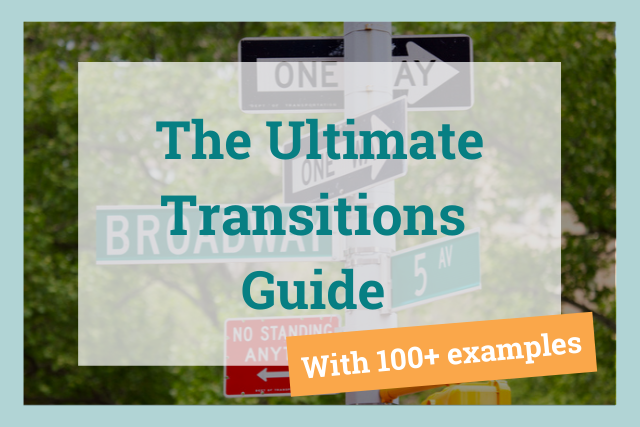
Imagine a road with no street signs to point the way. How would you follow the right route if you didn’t have a sign showing you which way to go?
Words and phrases like similarly , nevertheless , in order to , likewise , and as a result show the relationships between your ideas and can help illustrate agreement, contrast, or cause and effect.
What Are Transition Words?
Transition words are the road signs in writing. They help readers follow your train of thought without becoming bogged down trying to discern your meaning.
When used correctly, they keep up the flow of your writing as you shift in meaning, tone, and ideas from one sentence or paragraph to another. Transition words clarify the relationship between what you just said and what you're about to say for your readers.
Here’s an example of a well-placed transition:
- Original: The boy kicked the ball into the street. A speeding car came around the corner.
- Rewrite: The boy kicked the ball into the street. At the same moment, a speeding car came around the corner.
The rewrite uses a transition phrase to show when the event happened. We see the action in a wider lens: the ball goes into the street just as a car comes careening around the corner. The first illustration is short and choppy. It doesn’t flow well. The rewrite leads you smoothly between two related, but different thoughts.
The addition of at the same moment also clarifies the connection between the ideas for the reader. Since we know these events are connected and happening at the same time, we feel more tension for what's about to happen.
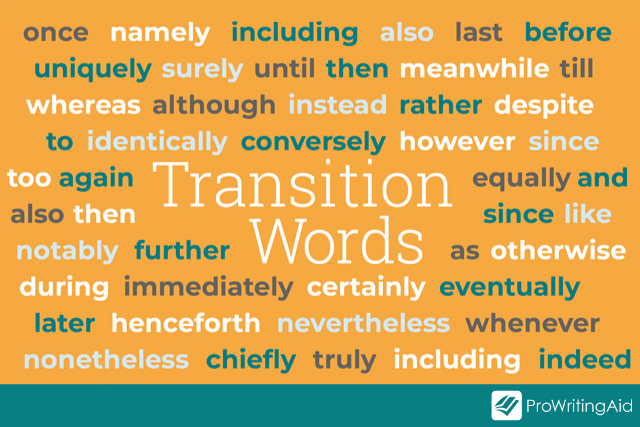
Transitional Words Examples: Fiction
Let’s take a look at some of these words in context to better examine how they work.
Fiction Transitions Example 1:
Take the following two sentences. Which one reads more fluidly?
- Mark tended to avoid the campus dining hall where his former friends hung out. He loved its food.
- Mark tended to avoid the campus dining hall where his former friends hung out, although he loved its food.
In the second construction, you understand how the two ideas are related. The first construction reads as choppy, two disparate ideas connected solely by proximity. By adding the transition word although and combining the two sentences, the second construction makes it clear that avoiding the dining hall had consequences for Mark. It gives more meaning to both sentences.
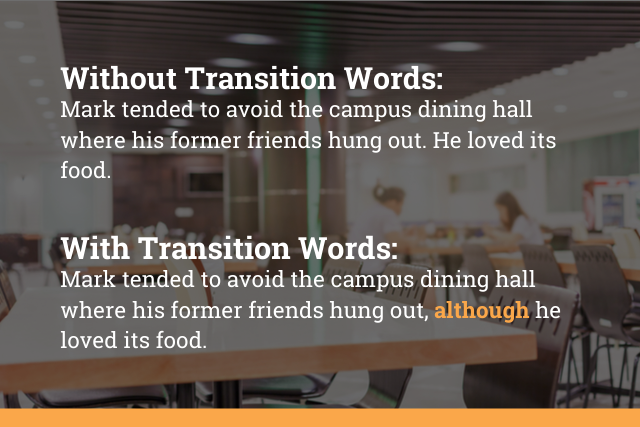
Fiction Transitions Example 2:
Here’s another example of transition word usage in fiction writing:
- Mindy thought her mother was over-reacting to her predicament. She waited two days after the first phone call to visit.
- Mindy thought her mother was over-reacting to her predicament. So, she waited two days after the first phone call to visit.
The use of so in the second construction makes clear to the reader that the gap in time between the call and the visit was a direct result of the over-reaction.
Transitional Words Examples: Non-Fiction
Transitions don’t just help fiction readers. Let’s take a look at how you can use transitions to improve your non-fiction writing.
Non-Fiction Transitions Example 1:
Take the following two constructions. Which one reads more fluidly?
- Marketing numbers have performed worse than we expected this year. We will be hiring a marketing consultant.
- Marketing numbers have performed worse than we expected this year, so we’ll be hiring a marketing consultant.
In the second construction, you understand how the two ideas are related. You see straight away that the poor marketing results are the direct reason for hiring a marketing consultant. By adding this connection, the relationship between the two ideas becomes clear. Similarly, the second version flows better and feels less self-contained.
Non-Fiction Transitions Example 2:
Here’s another example of transition word usage in non-fiction writing:
- The recent rise in oil pricing has made gas more expensive for consumers. Food prices have skyrocketed.
- The recent rise in oil pricing has made gas more expensive for consumers. Similarly, food prices have skyrocketed.
The use of similarly in the second construction makes it clear that there’s a relationship between the two ideas. The first construction feels disconnected since one sentence focuses on gas prices and another on food. The second construction makes it clear that the two ideas are related based on how they affect prices for consumers.
What Are the 6 Examples of Transitions?
What makes these phrases different from other words? They all move your writing from one idea to another.
The specific word or phrase you choose for your writing will depend on the type of transition you want to make. Each category of transition has multiple words or phrases you can choose from. Later in this article, we’ll show you hundreds of transition words or phrases to suit every need.
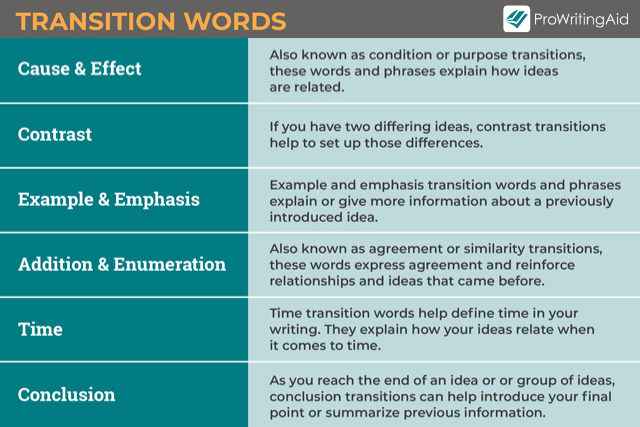
Before we get to the ultimate list of examples, let’s take a look at the categories.
Cause and effect: Show how two ideas are connected.
- I’m tired, so I’m going to bed.
Contrast: Show differences between two or more ideas.
- I hate most desserts. However, I love cookies.
Example and Emphasis: Introduce examples that help highlight or explain a previous point, or to add strength to a particular idea.
- I have a lot of fears. For instance, I’m terrified of spiders.
Addition & Enumeration: Break down, draw connections to, or add more support to an existing idea.
- Today, I’m going to do my homework. In addition, I’m going to clean my room.
Time: Explain how two or more ideas are related in time.
- Mary-Ann went out, looking for a bright new world. Meanwhile, Wanda looked all around their hometown and all she found was Earl.
Conclusion: Introduce a final point or summarize information.
- In conclusion, I deserve a new car because I’ve done all my chores for the month.
How ProWritingAid Can Help You with Transition Words
Clear, readable writing tends to use around 25% transition phrases. Of course this isn't set in stone—but if you have considerably fewer than this in your document, you may be losing your reader.
ProWritingAid's Transitions Report highlights all of the transition words in your document so you can see how your writing flows. Here's how it works:
Try out ProWritingAid's Transitions Report with a free account.
What Are Some Examples of Transition Words?
Looking for examples of transition words you can use in your writing? Look no further! We’ve put together the ultimate list with hundreds of examples you can use.
On to the list!
Cause and Effect Transition Phrases
Also known as condition or purpose transitions, these words and phrases explain how ideas are related.
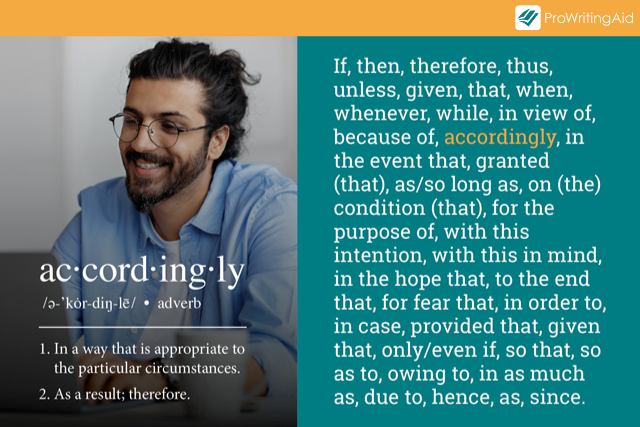
Contrast Transition Words
If you have two differing ideas, contrast transitions help to set up those differences.
Example and Emphasis Transition Words
Example and emphasis transition words and phrases explain or give more information about a previously introduced idea. Sometimes known as clarification transitions, these words help make your meaning more clear.
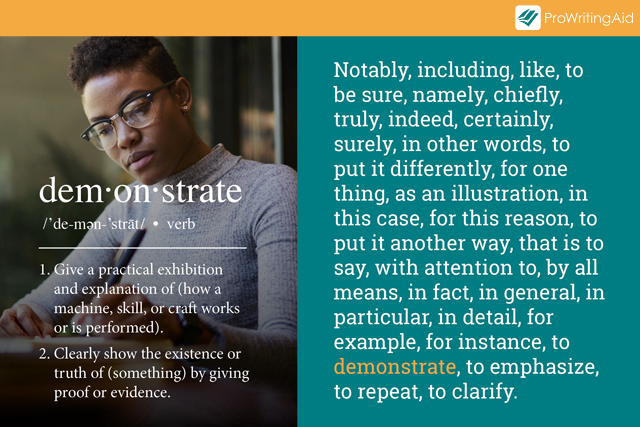
Addition and Enumeration Transition Words
Also known as agreement or similarity transitions, these words express agreement and reinforce relationships and ideas that came before.
Time Transition Words
Time transition words help define time in your writing. They explain how your ideas relate when it comes to time.
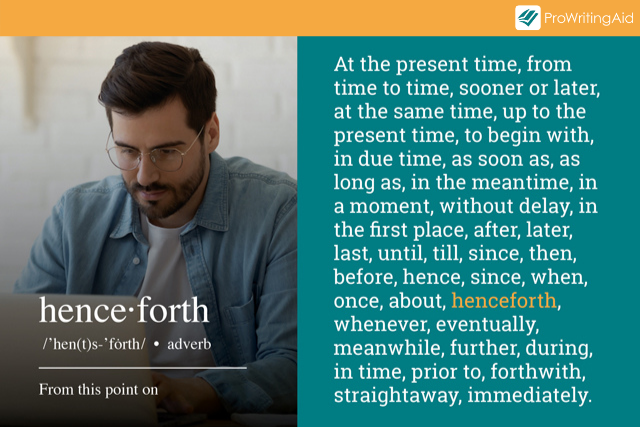
Conclusion Transitions
As you reach the end of an idea or or group of ideas, conclusion transitions can help introduce your final point or summarize previous information.
How to Use Transition Words More Effectively
Using transition words and phrases isn’t always as easy as it looks. Here are some best practices to keep in mind so that you can effectively use transition words.
1. Understand the relationship between your ideas
The better you understand the relationships between the ideas in your text, the more effectively you’ll be able to wield transition words and phrases. The relationships between your ideas will help you understand which you should pick.
2. Know your transition words
Different transitions are appropriate in different contexts. Don’t just pick a random transition to use. Make sure the one you’ve chosen is appropriate for what you’re trying to say. Also, don’t be afraid to try out a new transition word from the list we’ve provided above. Just like in other types of writing, repetitive language can be boring for your readers. Try out new transition words (as long as they’re the right type) to increase the interest of your writing.
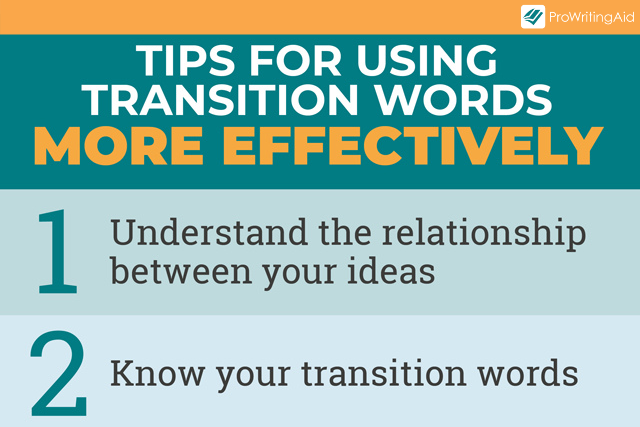
How ProWritingAid Helps You Improve Transition Words and Phrases in Your Writing
Since transitions help to organize your ideas and demonstrate connections, it’s important to include them in your writing to make it more clear. ProWritingAid can help. Our software analyzes your writing to determine whether or not you’ve used transitions appropriately in your work.
Depending on what you’re writing, you can find your Transitions score in two places: your goals and the Transition Report.
ProWritingAid knows that different genres require different amounts and types of transitions, so your suggested transition percentage changes depending on what you’re writing. If you’re working on an academic paper, for instance, transitional phrases are important to improving understanding. So you’ll find a goal for transitions in your sidebar.
On the other hand, formal transitions are less common in some types of fiction writing, so you may not see this goal if you’re working on say, a crime novel.
You can always find your score, regardless of what you’re writing, by running the Transition Report. The ProWritingAid Transition Report will scan your writing and give you a “transitions score." This measures the percentage of your sentences that begin with a transition word.
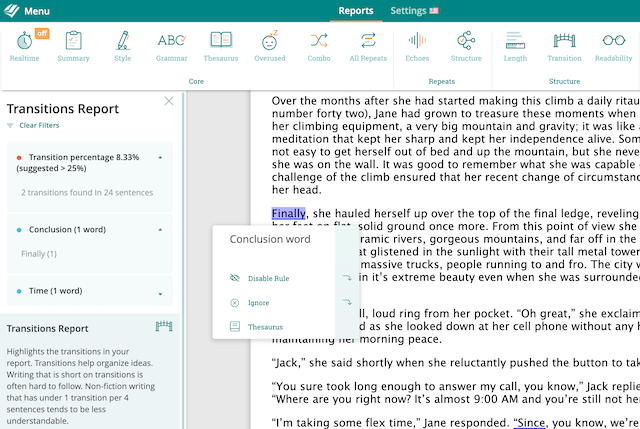
Check your transitions with a free ProWritingAid account.
Transitions: The Links Between Ideas
To conclude, great transitions lead to more sophisticated structure. (See what we did there with that transition?!)
Adding transitions to your writing creates clear connections for your readers. By adding transitions, you’ll help your readers better understand what you’re trying to say.
Happy writing!
Looking for more great editing advice? Download this FREE eBook:

Book cover: 20 Editing Tips From Professional Writers
Whether you are writing a novel, essay, article, or email, good writing is an essential part of communicating your ideas., this guide contains the 20 most important writing tips and techniques from a wide range of professional writers., common questions about transition words and phrases in english, transition usage, learn more about grammar:, your personal writing coach.
A grammar guru, style editor, and writing mentor in one package.

Drop us a line or let's stay in touch via :
Connecting Ideas Through Transitions
Writing that Establishes Relationships and Connections between Ideas
Introduction Common Kinds of Relationships Writers Establish between Ideas Cohesion Coherence Transition Words and Phrases
Introduction
According to poet and science writer Diane Ackerman, “one of the brain’s deepest needs [is] to fill the world with pathways and our lives with a design.” We naturally look for how things are related. In writing, this means that readers tend to assume that two side-by-side sentences or adjacent paragraphs relate to each other. If the pathways and design of your writing aren’t clear to readers, readers will either get confused or frustrated or try to mistakenly intuit their own connections. Both responses can be disastrous.
Good writing provides clear passages through all of your ideas so that readers don’t get lost or start to blaze their own conceptual trail. These connections between ideas occur at the sentence, paragraph, section, and (for longer works) even chapter level. As a writer, it is your responsibility to make sure that your readers follow this progression, that they understand how you arrive at your various ideas and how those ideas relate to each other. In this page, we explore how to make your connections between ideas understandable by using common relationship categories to compose sentences that are cohesive, paragraphs that are coherent, and transitions that clearly order and introduce ideas.
Common Kinds of Relationships Writers Establish between Ideas
Writers are always working to establish clear relationships between and within all of their ideas. Consider how Derek Thompson moves naturally between one concept to another in this short passage from his The Atlantic feature about the future of jobs entitled “A World Without Work”:
[1] One common objection to the idea that technology will permanently displace huge numbers of workers is that new gadgets, like self-checkout kiosks at drugstores, have failed to fully displace their human counterparts, like cashiers. [2] But employers typically take years to embrace new machines at the expense of workers. [3] The robotics revolution began in factories in the 1960s and ’70s, but manufacturing employment kept rising until 1980, and then collapsed during the subsequent recessions.
In the first sentence, Thompson begins with an idea that is familiar to readers at three different levels. The argument that machines haven’t replaced all retail employees and therefore won’t do so in the future is common to anyone who has thought much about workplace technology. This idea is also specifically familiar to the individuals who have been reading Thompson’s article. Finally, Thompson makes this idea even more familiar by connecting it to an example that his readers are familiar with: the effects of self-checkout kiosks. In his second sentence, Thompson uses the transition word “but” to establish a contrastive relationship; what he is about to say in some way opposes what he just said. He concludes this passage with a sentence providing chronologically organized evidence for the idea he raised through that contrast. In this example, he very quickly leads us from the 1960s to the late 20 th century and is able to cover a lot of ground clearly because he starts with happened earlier and concludes with what has happened more recently.
In just these three sentences, we can see Thompson establishing different kinds of relationships between concepts. He is:
- guiding us from familiar ideas into unfamiliar ones,
- comparing two unlike things,
- providing examples for his claims, and
- presenting information chronologically.
Familiarity, contrast, example, and chronology are four common ways that topics can be related, but there are several others. The following lists identifies key relationships that we tend to find naturally in the world around us when we ask questions like, “Why did that happen?” and, “How do these two things fit together?” If you can obviously situate any your ideas within these well-known structures, then readers will be able to more quickly understand the connections you are establishing between your ideas. In the list that follows we identify these common relationship categories, explain them, and provide examples of sentences that establish these kinds of relationships. (All off these sample sentences are about research in Lake Mendota—the body of water just north of the UW-Madison campus.)
Familiarity– Connecting what readers know to what they don’t known.
Learning often involves drawing from existing knowledge in order develop new knowledge. As a result, this is one of the most important relationships you can establish in your writing. Start with what your readers know (either because you can assume a common knowledge or because you’ve already told them about this earlier in your paper or even in the preceding sentence) in order to then take them to something they don’t know.
Example: When you dive into a lake for a quick swim, you’re actually entering a diverse limnology laboratory—the research field for the ecologists who study inland waters.
Causation– Connecting the instigator(s) to the consequence(s)
We are very familiar with thinking about ideas and processes in relationship to cause and effect. You can use the prevalence of this relationship to your advantage by relating your ideas to causation.
Example: In the mid-19 th century, the white sand beaches that used to line Lake Mendota were engulfed by the additional four feet of water that the Tenney Locks brought into the lake (Van Eyck).
Chronology– Connecting what issues in regard to when they occur.
This is particularly useful if you are describing a sequence of events or the steps of a process.
Example: In 1882, E.A. Birge was gathering data about the prevalence of blue-green algae in Lake Mendota (Van Eyck). By 1897, he was publishing about plankton (Birge). Even when he became president of UW-Madison several years later, his interest in freshwater lakes never waned (“Past presidents and chancellors”).
Combinations
Lists–connecting numerous elements..
You can think of this as a “this + this + this” model. You are saying that a collection of concepts or elements contribute equally or simultaneously to something. Within lists, it’s still important that you are being strategic about which elements you are identifying, describing, or analyzing first, second, and third.
Example: Across its studied history, Lake Mendota has been negatively affected by blue-green algae, Eurasian milfoil, spiny water fleas, and zebra mussels, among others (Van Enyck).
Part/Whole— Connecting numerous elements that make up something bigger.
This is a “this + this + this = that” model. You are showing how discrete elements form something else through their connections.
Example: Across generations, the damage Lake Mendota has sustained as a result of the unnaturally prolific prevalence of blue-green algae, Eurasian milfoil, spiny water fleas, and zebra mussels has irreparably altered these waters.
Contrast– Connecting two things by focusing on their differences.
This establishes a relationship of dis-similarity. It helps readers understand what something is by comparing it with something that it is not.
Example: But whereas boosting the population of walleye and northern perch in Lake Mendota effectively reduced the prevalence of Eurasian milfoil, scientists haven’t been able to develop a plan to respond to the damaging spiny water fleas (Van Eyck).
Example– Connecting a general idea to a particular instance of this idea.
Arguments are made more understandable and persuasive when you develop your overall claims in relationship to specific evidence that verifies or exemplifies those claims. Which examples will be the most persuasive (e.g., statistical data, historical precedent, anecdotes, etc.) will depend on the knowledge, interests, disposition, and expectations of your reader.
Example: “These new challenges demand new solutions, some behavioral (such as cleaning boats from lake to lake) and some research-driven (for example, identifying a natural predator for the invasive species)” (Van Eyck).
Importance– Connecting what is critical to what is more inconsequential.
This can also be thought of as connecting what is big to what is small. You may also choose to reverse these relationships by starting with what matters least or what is smallest and building to what is the most important or what is the most prominent. Just make sure that you are helping your reader understand which end of the spectrum you are starting with.
Example: Boaters were inconvenienced by the Eurasian milfoil clogging their propellers, but the plants’ real harm was dealt to the lake’s native flora and, consequently, its fish (Van Eyck).
Location– Connecting elements according to where they are placed in relationship to each other.
Even if you aren’t writing about geographical entities, you can still clarify how various ideas are positioned in relationship to each other.
Example: Whether or not the lake is pretty is peripheral to the issue of whether or not its natural ecosystems are in balance.
Similarity– Connecting two things by suggesting that they are in some way alike.
This highlights commonalities to show readers how elements or ideas are serving the same function.
Example: Just as invasive water flora (i.e., Eurasian milfoil) disrupted Lake Mendota’s ecosystem in the 1970s, in 2009 scientists discovered that the lake was being damaged by invasive water fauna (i.e., spiny water fleas) (Van Eyck).
While the examples provided above for each of these relationships is a sentence or short series of sentences where relationships are established through sequencing and transition words, you should also develop these kinds of common connections between ideas on a large scale through grammatical parallelism, paragraph placement, and your progression from one section to another.
Also, as can be seen in these examples, sometimes multiple different relationships are functioning simultaneously. For instance, consider again the example for the “Importance” item:
The ideas in this sentence work within the following relationship categories:
- Importance—Connecting what is more inconsequential (i.e., how boaters are bothered by Eurasian milfoil) to what is most critical (i.e., how the lake’s ecosystem is disrupted by Eurasian milfoil),
- Contrast—Connecting two things (i.e., boaters’ concerns and the lake’s wellbeing) by focusing on their differences,
- Causation—Connecting an instigator (i.e., Eurasian milfoil) to consequences (i.e., native plants’ destruction and, secondarily, the native animals’ destruction).
This collection of interwoven relational connections doesn’t mean that these ideas are jumbled; this is just an indication of how relationships can become interconnected.
Since clearly working within these relationship categories can be useful for organizing your key concepts as well as guiding readers through the structure of entire papers or particular paragraphs as well as sentences, different kinds of connections can be similarly layered across the whole structure of a paper. For example, if you are composing an argument about why it’s so hard for meteorologists to pin-point the severity and location of tornadoes, the overarching relationship of your ideas might be part/whole because you’re interested in how a range of factors contribute to a difficult prediction process. However, within your paragraphs, you might have to use chronological and causation relationships to describe the physical processes by which tornadoes are formed. And from sentence to sentence, you’ll need to make sure that you are starting with what’s familiar to your readers before moving into what’s new.
Joseph Williams and Joseph Bizup, in their handbook Style: Lessons in Clarity and Grace , identify the process of moving from what is known to what is unknown as “cohesion.” “Sentences are cohesive ,” they write, “when the last few words of one sentence set up the information that appears in the first few words of the next” (67). They relate this careful sequencing to the issue of “flow”—readers find that ideas follow each other naturally when one sentence begins where the previous sentence left off.
Consider another annotated example passage from Derek Thompson’s economic analysis of the effects of automation and technology on jobs. This paragraph comes after one about how horses (once primary forces for industrial production) were made obsolete by transportation technology.
[1] Humans can do much more than trot, carry, and pull. [2] But the skills required in most offices hardly elicit our full range of intelligence. [3] Most jobs are still boring, repetitive, and easily learned. [4] The most-common occupations in the United States are retail salesperson, cashier, food and beverage server, and office clerk. [5] Together, these four jobs employ 15.4 million people—nearly 10 percent of the labor force, or more workers than there are in Texas and Massachusetts combined. [6] Each is highly susceptible to automation, according to the Oxford study.
Thompson’s most obvious application of Williams and Bizup’s concept of cohesion happens at the end sentence 4 and the beginning of sentence 5 where he first lists four professions (salesperson, cashier, server, and clerk) then begins the next sentence with, “these four jobs.”
But even on a conceptual level, Thompson is continuously moving from old information to new information. Consider this analysis of the conceptual shifts within each of these six sentences where Thompson’s ideas have been stripped down and his key concepts have been highlighted in different colors:
[1] Humans have more skills than horses. [2] Humans’ full range of skills aren’t always utilized by many office jobs . [3] Many jobs don’t push us to our full potential. [4] Here are the most common jobs . [5] These jobs employ many people. [6] These jobs could be eliminated through automation .
Thompson begins this paragraph by connecting a new idea (i.e., humans’ present occupational relationship to technology) to an old idea from the previous paragraph (i.e., horse’s past relationship to technology). After introducing the human subject, he then uses it to bring in his next topic: workplace skills. Then, through skills he brings in the issue of jobs, and jobs eventually lead him to the issue of automation. This sequence holds together like a line of conceptual dominoes.

Connecting new ideas to old is a practice that you should implement across sentences, paragraphs, and even whole sections of your writing. However, be careful. If this practice becomes heavy-handed or overdone, your writing can become patronizing to your readers. Make sure that you are clearly and comprehensively connecting ideas and not just sequencing subjects.
In Style: Lessons in Clarity and Grace , Joseph Williams and Joseph Bizup also write about the importance of coherence. While “cohesion” and “coherence” sound similar, they are two different things. “Cohesion” is about ideas that connect to each other “the way two pieces of a jigsaw puzzle do,” whereas “coherence” “is when all the sentences in a piece of writing add up to a larger whole” (69). Sometimes this is also called “unity.” Coherence is achieved when the things you are writing about all clearly contribute to the same overarching topic. For example, let’s return to the domino example from above. The movement from humans to skills to jobs to automation works because Thompson’s larger article establishes a thematic connection between all of these topics: work changes in response to technological developments. Thompson is even able to start this paragraph with an otherwise unexpected reference to horses because in the previous paragraph he has shown his readers how horses also relate to this theme of work changing in response to technological development. Within your writing, it’s important to make sure that all of your smaller ideas are related to and pointed towards the same goal.
Williams and Bizup suggest one way of making sure that your writing is coherent or unified is to pay attention to what each of your sentences is about—its subject (the noun or pronoun that guides a sentence) and topic (the idea that is the focus of that sentence). In most sentences, your subject and topic should be the same thing. Also, most of the time your topic should be short and direct, and each paragraph should be primarily dedicated to one topic. As an example, consider again this paragraph from the Thompson article about human skills, jobs, and automation. The subjects/topics of each sentence have been highlighted.
1] Humans can do much more than trot, carry, and pull. [2] But the skills required in most offices hardly elicit our full range of intelligence. [3] Most jobs are still boring, repetitive, and easily learned. [4] The most-common occupations in the United States are retail salesperson, cashier, food and beverage server, and office clerk. [5] Together, these four jobs employ 15.4 million people—nearly 10 percent of the labor force, or more workers than there are in Texas and Massachusetts combined. [6] Each is highly susceptible to automation, according to the Oxford study.
Note that after setting up this paragraph in a way that connects back to the previous paragraph’s focus on horses, Thompson settles into the issue of jobs as his clear and primary focus. The final four sentences have some version of “jobs” as their subject and topic. This consistency allows him to develop coherent ideas about this one issue.
For more information about writing intentionally structured and unified paragraphs, check out our resource on paragraphing. Additionally, if you are trying to discern whether or not your paragraphs are functioning coherently across your entire paper, we recommend the practice of reverse outlining. You can find out more about this technique here.
Transition Words and Phrases
The best way to clearly communicate the logical pathways that connect your ideas is to make sure that you move smoothly from old information to new information (cohesion) and that your readers always understand how your primary topics contribute to the big picture of your overall argument (coherence). While we’ve considered ways that whole sentences and paragraphs can do this work, sometimes even individual words can help you establish clear, cohesive, and coherent relationships between your ideas. In writing these are often called “transition words.”
The following is a list of useful transition words and phrases. Following the list of common relationship categories provided above, these words are organized according to the kinds of relationships they frequently develop. Of course, establishing clear relationships between ideas requires much more than just dropping one of these into the start of a sentence, but used sparingly and carefully based on the logical associations they establish, these words can provide usefully obvious indications to your readers of the kind of connections you are trying to develop between your ideas.
Causation– Connecting instigator(s) to consequence(s).
accordingly as a result and so because
consequently for that reason hence on account of
since therefore thus
after afterwards always at length during earlier following immediately in the meantime
later never next now once simultaneously so far sometimes
soon subsequently then this time until now when whenever while
Combinations Lists– Connecting numerous events. Part/Whole– Connecting numerous elements that make up something bigger.
additionally again also and, or, not as a result besides even more
finally first, firstly further furthermore in addition in the first place in the second place
last, lastly moreover next second, secondly, etc. too
after all although and yet at the same time but
however in contrast nevertheless nonetheless notwithstanding
on the contrary on the other hand otherwise though yet
as an illustration e.g., (from a Latin abbreviation for “for example”)
for example for instance specifically that is
to demonstrate to illustrate
chiefly critically
foundationally most importantly
of less importance primarily
above adjacent to below beyond
centrally here nearby neighboring on
opposite to peripherally there wherever
Similarity– Connecting to things by suggesting that they are in some way alike.
by the same token in like manner
in similar fashion here in the same way
likewise wherever
Other kinds of transitional words and phrases Clarification
i.e., (from a Latin abbreviation for “that is”) in other words
that is that is to say to clarify to explain
to put it another way to rephrase it
granted it is true
naturally of course
finally lastly
in conclusion in the end
to conclude
Intensification
in fact indeed no
of course surely to repeat
undoubtedly without doubt yes
for this purpose in order that
so that to that end
to this end
in brief in sum
in summary in short
to sum up to summarize
Works Cited
Ackerman, Diane. “I Sing the Body’s Pattern Recognition Machine.” The New York Times , 15 June 2004. https://www.nytimes.com/2004/06/15/science/essay-i-sing-the-body-s-pattern-recognition-machine.html . Accessed 6 June 2018.
Birge, Edward Asahel. Plankton Studies on Lake Mendota . Harvard University Library of the Museum of Comparative Zoolog., 1897.
“Past presidents and chancellors.” Office of the Chancellor , University of Wisconsin-Madison, 2016. https://chancellor.wisc.edu/past-presidents-and-chancellors/ . Accessed 16 June 2018.
Thompson, Derek. “A World Without Work.” The Atlantic , July/August 2015, https://www.theatlantic.com/magazine/archive/2015/07/world-without-work/395294/. Accessed 14 June 2018.
Van Eyck, Masarah. “Lake Mendota: a scientific biography.” L&S News , College of Letters and Sciences University of Wisconsin-Madison, 29 Aug. 2016. http://ls.wisc.edu/news/lake-mendota-a-scientific-biography . Accessed 15 June 2018.
Williams, Joseph M. and Joseph Bizup. Style: Lessons in Clarity and Grace . 12 th ed., Pearson, 2017.

Improving Your Writing Style
This is an accordion element with a series of buttons that open and close related content panels.
Clear, Concise Sentences
Use the active voice
Put the action in the verb
Tidy up wordy phrases
Reduce wordy verbs
Reduce prepositional phrases
Reduce expletive constructions
Avoid using vague nouns
Avoid unneccessarily inflated words
Avoid noun strings
Transitional Words and Phrases
Using Transitional Words and Phrases
The Professional Writer’s List of Transition Words & Phrases
Updated: July 24, 2019
Published: November 27, 2018
Talking to someone who constantly jumps from one unrelated topic to the next is a strange experience. The entire conversation seems random and unfocused, which makes it hard to stay engaged, and easy to say, “I gotta go”.

Needless to say, it’s annoying to talk to people who try to engage you with choppy conversations -- and it’s just as irritating in writing. If you abruptly hop from one point to another, you’ll throw your readers off and confuse them, increasing the likelihood that they’ll abandon your piece.
To avoid losing your audience’s attention when moving from one point to another, you need to weave your ideas and thoughts together with transitions. These logical connections between different sections in your writing give your audience a train of thought to follow, boosting the odds that they’ll pay their undivided attention to your piece.
To help you thread your writing together and better engage an audience, we’ve compiled a list of the best transition words and phrases to include in your pieces. Whether you want to know the best transitions for linking separate paragraphs together or ending paragraphs with an emotional punch, we’ve listed some effective options below.

The Professional Writer’s List of Transition Words and Phrases
Additional evidence.
To bolster your ideas with additional support or information, consider using the following transitions:
- In addition
Here’s an example of this type of transition in use:
“Early adopters can provide a lot of helpful feedback about a product’s or technology’s pros and cons. They also inject these companies with revenue that funds the research and development needed to enhance the product or technology enough to gain widespread adoption.”
To compare multiple thoughts or ideas, consider using the following transitions:
- By the same token
- In a similar fashion
“ Just like Facebook Instant Articles, which lets users read articles without leaving Facebook’s mobile app, Google will host AMP pages on its own servers and serve up the content directly on its site.”
To contrast multiple ideas or thoughts, consider using the following transitions:
- On the other hand
- At the same time
- Even though
- In spite of
“As jobs become more specialized in today’s workforce, it seems logical to hone a specific skill set, especially during school. But only learning the skills that match the exact requirements of a job today might not prepare you for your job tomorrow.”
To describe something that happened, happens, or will happen during a certain time frame, consider using the following transitions:
- Immediately
- Simultaneously
“ Nowadays , writing a letter can seem completely archaic. I mean, do people even send mail anymore? Or do they only communicate through email and messaging?”
To describe two things happening at the same time, consider using the following transitions:
“Clifford sat alone and depressed in detention. Meanwhile , his friends were having a blast playing football at the common ground.”
Clarification
To spell out a complicated concept, consider using the following transitions:
- In other words
- To rephrase
- To put it another way
“The term “Bitcoin mining” is really just a clever metaphor for the intricate proof-of-work system that gives people bitcoins in exchange for validating the cryptocurrency’s transactions. In other words , the reason why people mine Bitcoin and how they actually do it is complicated.”
Exemplification
To help your readers grasp an abstract concept, try using the following transitions to provide them with a concrete example:
- To illustrate
- To demonstrate
- For instance
- For example
“Even if experiences end like your relationships with material objects do, they’ll always be a part of your story, allowing you to bond with other people who’ve shared similar experiences. For instance , who do you think you’ll connect with on a deeper level -- someone who also studied abroad in Scotland during college or someone who wears the same Apple Watch as you?”
Identification
To highlight a distinct attribute of your idea or thought, consider using the following transitions:
- Specifically
- Particularly
“If brands truly want to rise from the ashes of the retail apocalypse, they must stay laser-focused on adapting to the evolution of this technology and their customers' preferences. More specifically , they need to embrace change and prepare for the upcoming trends that will transform their industry in 2019.”
To emphasize a thought or idea you just previously stated, consider using the following transitions:
- More importantly
“When the World Wide Web launched in 1991, most people thought it would fizzle out in a few years. Experts considered it to be a shiny, new fad that no one was really using. In fact , only six countries in the world had more than one internet user per 100 people that year.”
To spotlight the root cause of something happening, consider using the following transitions:
“Strong call-to-actions are a crucial element of a persuasive business letter -- because if you don't tell your reader what to do next, you might as well have never written your letter in the first place.”
To call attention to the consequence of the root cause of something, consider using the following transitions:
- As a result
- Subsequently
- Consequently
“A lot of professionals overlook the importance of writing high-quality business letters because they seem outdated. As a result , most people don’t actually know how to write one.”
To flow from one related topic to another, try referencing the previous topic by using the following transitions:
- With this in mind
- On the subject of
- Considering
“Inlinking with clear, concise, and relevant anchor text can reinforce the topical connection between certain posts in Google’s eyes and help all of those posts rank better. With this in mind , anchor text is nothing to gloss over, so let’s learn more about what exactly anchor text is, why it’s important, and the different types of anchor text."
Summary/Conclusion
To summarize or conclude a paragraph, consider using the following transitions:
- In a nutshell
- To put it briefly
“Traveling make you more open to new experiences, which increases your willingness to try new things in the future. It also increases your brain’s capacity and attentiveness in future situations that are new and challenging. In a nutshell , traveling strengthens your desire and ability to learn new skills.”

Don't forget to share this post!
Related articles.
![transition words in creative writing How to Write a Memo [Template, Examples & HubSpotter Tips]](https://blog.hubspot.com/hubfs/how-to-write-memo_0.webp)
How to Write a Memo [Template, Examples & HubSpotter Tips]

9 Simple Ways to Write a Good Introduction Sentence

Comma Rules for Clear Writing (with Examples)

How to Write an Introduction: A Simplified Guide

How to Become a (Better) Editor: 13 Editorial Tips
![transition words in creative writing How Long Should Blog Posts Be in 2021? [New Data]](https://blog.hubspot.com/hubfs/how-long-blog-posts.webp)
How Long Should Blog Posts Be in 2021? [New Data]

How to Improve Your Writing Skills and Escape Content Mediocrity (Infographic)

How The Flesch Reading Ease Test Can Help You Write Clear and Concise Copy

HubSpot's Guide to Becoming a Better Writer

What is a Metaphor? A 2-Minute Rundown
Save time creating blog posts with these free templates.
Marketing software that helps you drive revenue, save time and resources, and measure and optimize your investments — all on one easy-to-use platform

Blogs for English Excellence
How to Use Vocabulary in Creative Writing to Make Brilliant Stories
If you want to be a writer or really like writing, it’s important to know that vocabulary in creative writing is very important – as it can help you be the best writer you can be.
Creative writing is the way for people to express themselves and share their imaginative stories with others. It doesn’t follow regular writing rules, so it allows writers to create stories, poems, and essays that deeply connect with the readers’ emotions. When you are writing in a creative approach, it is very important to have a large and strong set of words that you know and understand well. This allows you to express your thoughts clearly, create strong mental pictures, and provoke feelings in your readers’ mind.
With Vocavive App , we have been helping students learn and master a strong collection of important English vocabulary. Having this kind of collection of a wide range of words helps writers express their ideas clearly and genuinely, making their creative ideas come alive on paper.
In this article, we will further discuss the words that can greatly help you to create a well-crafted story. We will give you helpful advice and tips to improve your writing skills – which includes choosing the right words, avoiding using the same words too much, and using good transitions.
Let’s get started?
Exploring the Significance of Vocabulary in Creative Writing
Creative writing is incredibly important because it lets us express ourselves and connect with others. It allows us to unleash our imagination, share personal stories, and evoke emotions in readers. The best kind of Creative writings have a great storytelling . They are full of rich expressions that take the reader through a journey.
Now, when it comes to writing effectively, having a good vocabulary is vital. Why?

A wide range of words helps us to convey our thoughts, emotions, and visuals in the best possible way. The work gets easier for the writer. But is it only that?
It also enables us to create vivid imagery in readers’ minds, develop intriguing characters, and construct realistic worlds. Numerous research studies have demonstrated this link between a strong vocabulary and writing proficiency. Research conducted by the Educational Testing Service (ETS) reveals that a larger vocabulary enhances the quality and complexity of writing. When we know and use a variety of words, our writing becomes more creative, clear, and profound.
Another study published in the Journal of Educational Psychology found that students with an extensive vocabulary tend to produce more engaging and captivating stories.
Overused Words That Will Make Your Writing Sound Weak
Using a variety of words is important when writing creatively. However, we should try not to use words and phrases which have been used too much in creative writing. We might use those words thinking it will improve the richness, when in fact, it can do the opposite. Those commonly used and overused words can make our writing sound boring and unoriginal.
Let’s look at a list of commonly used words that we should be careful not to use too much.
- Awesome – The word “awesome” is used too much and doesn’t give enough details to describe something impressive or remarkable.
- Beautiful – A word that is often used without giving any specific details or personal viewpoints.
- Brilliant – The word “brilliant” is often used to say something is really good or smart, but it might sound overused.
- Cool – An informal word that many people use a lot, but it doesn’t give a clear meaning anymore.
- Cute – Often used to describe something charming or appealing, but it can be used too much and become unoriginal.
- Different – Different is a word that is commonly used to describe something but doesn’t give much information or understanding about it.
- Simple – Simple things are repeated too much and don’t have much meaning, so they don’t show all the details or difficulties involved.
- Great – A word that is often used but it doesn’t provide many details and can be unoriginal.
- Nice – A word that is used too much and doesn’t have enough clear details to describe something well.
- Really – Often used as a word that doesn’t have much meaning and doesn’t make things clearer or more important.
- Amazing – Often used without giving details or showing the real specialness of something.
- Surprising – Used too much and doesn’t have a strong effect because people use it to describe things that happen or experiences that they have frequently.
- Breathtaking – It has been used so much that it lost some of its power and impact.
- Difficult – Often used without giving specific details or explanations about the difficulties being talked about.
- Compelling – Means when something is persuasive or captivating, but it is often used too much and lacks originality.
- Important – Often used to highlight significance without giving different viewpoints or specific details.
- Dramatic – Often used to describe something intense or powerful, but can be unoriginal.
- Effective – Effective is a word we use a lot but it doesn’t tell us much and doesn’t give us any new or special information about what we’re talking about.
- Encouraging – Means giving support or motivation, but it is often used without giving examples or details to explain why it is encouraging.
- Exciting – A word that people use too much, and it’s not very specific in describing the real nature or specialness of an exciting experience or event.
- Fabulous – Frequently used to describe something exceptional or marvelous, but its frequent usage has diminished its impact.
- Fantastic – Often employed as a generic term to convey excitement or positivity, but can lack specificity and originality.
- Fascinating – A common choice to describe something intriguing or captivating, but its frequent usage can make it sound clichéd.
- Fortunate – Frequently used without providing unique details or perspectives on the nature of the good fortune.
- Genius – Overused to describe exceptional intelligence or talent, but its frequent use can diminish its impact.
- Helpful – A commonly used term that lacks specificity, failing to convey the specific ways in which something or someone is helpful.
- Incredible – Often used generically to express disbelief or awe, but its frequent usage can dilute its impact.
- Inspiring – Frequently used to describe something that motivates or encourages, but can sound clichéd without offering specific examples.
- Interesting – A generic term used to convey engagement or curiosity, but its overuse can make it sound unoriginal.
- Magnificent – Frequently used to describe something grand or impressive, but its frequent usage can lessen its impact.
- Memorable – Often used without providing specific details or insights into what makes something truly memorable.
- Outstanding – A common descriptor for excellence, but its overuse can make it sound less impactful or unique.
- Powerful – Frequently used to convey strength or influence, but its frequent usage can make it lose some of its impact.
- Remarkable – Often used to describe something extraordinary or noteworthy, but its frequent usage can diminish its impact.
- Significant – A frequently used term to express importance or meaning, but its overuse can make it sound clichéd.
- Spectacular – Often used to describe something visually stunning or impressive, but its frequent usage can make it lose impact.
- Striking – Frequently used to describe something visually or emotionally impactful, but its overuse can diminish its effect.
- Substantial – A common term used to convey importance or size, but its overuse can make it sound generic or lacking in specificity.
- Successful – Often used without providing specific criteria or context for defining success.
- Surprising – Frequently used to convey unexpectedness, but its overuse can make it sound less impactful or genuine.
- Terrific – A commonly used term to express enthusiasm or positivity, but its frequent usage can make it sound clichéd.
- Unique – Often used to describe something one-of-a-kind or distinct, but its frequent usage can diminish its impact.
- Valuable – Frequently used to express worth or importance, but its overuse can make it sound less impactful or specific.
- Vivid – A commonly used term to describe something vibrant or intense, but its frequent usage can make it sound unoriginal.
- Wonderful – Often employed as a generic term to convey delight or positivity, but its frequent usage can diminish its impact.
- Worthwhile – Frequently used to express value or significance, but its overuse can make it sound less impactful or meaningful.
Use these 14 Types of Transition Vocabulary In Creative Writing
Effective transitions help connect ideas and make it easier for readers to follow along with the story or information. By using connecting words and phrases, writers often make their work easier to understand and flow better. Here are the Transition Words and Phrases you should keep in your volt.
Addition: again, also, besides, too, furthermore, moreover, in addition, first, second, third, next, lastly
Contrast: but, however, nevertheless, on the other hand, conversely, yet, although, even though, while, whereas
Comparison: similarly, likewise, in the same way, as, just as, than, like
Cause and Effect: because, therefore, thus, hence, as a result, consequently, so, for this reason, due to
Time: after, before, during, since, then, when, while, afterwards, next, finally, initially
Sequence: first, second, third, next, then, afterward, finally, to begin with, to start with
Emphasis: indeed, in fact, certainly, of course, truly, really, definitely, undoubtedly
Restatement: in other words, to put it another way, that is, as I said, in short
Clarification: to be more specific, to clarify, in other words, that is to say
Summarization: in summary, to sum up, all in all, in conclusion, to conclude
Example: for example, for instance, to illustrate, as an illustration, as shown
Concession: admittedly, it is true that, I agree that, I grant that, I will admit that
Refutation: however, on the contrary, yet, still, nevertheless, in spite of
Concluding Remarks: to conclude, in conclusion, in summary, to sum up, all in all
Question: How do I Use These Transition Words to Create a More Compelling Read?
To make your paragraphs flow better, it’s important to keep a few practical tips around you that connect your ideas smoothly. First, think carefully about how to move smoothly from one idea to another in your writing. Plan out the order that makes the most sense for your thoughts.
By doing this, you can find out where you need to use transition words and phrases to help readers understand how ideas are connected. Try out different connectors like “also,” “however,” or “likewise,” to keep your readers interested and add some variety to your writing.
Make sure to think about the situation and what you want to say when you write. Choose words that clearly show how your ideas connect to each other. It’s important to put transitions in the right places in sentences to make sure the writing flows smoothly and makes sense. You can put them at the start, in the middle, or at the end of sentences.
Vocabulary Gems to Dazzle Your Teacher in Essay Writing
As students, we often find ourselves striving to impress our teachers with well-crafted answer scripts. Beyond accurate content, an impressive essay demands the strategic use of vocabulary to showcase our language prowess and command over the subject matter. Let’s take a look at it with an example.
Before Using Vocabulary:
Imagine you are writing an essay about the American Revolution. In the fayirst scenario where there is no vocabulary, your essay may read like this –
“The American Revolution was a significant event in history. The colonists fought against British rule for their freedom.”
After Using Vocabulary:
Now, let’s see the same essay with an improved vocabulary usage –
“The American Revolution stands as a pivotal milestone in history, epitomizing the relentless spirit of the colonists who valiantly waged a battle for their emancipation from British dominion .”
Which one do you think has more richness?
See, the “after” scenario here elevates the description of the American Revolution by incorporating words like “pivotal milestone,” “relentless spirit,” and “valiantly waged a battle.”
Your classroom might have 20+ students. To stand out from the general crowd, you can use vocabulary like these. It not only demonstrates a more nuanced understanding of the said topic, but it also brilliantly captures the attention of the reader, including your teacher. She might feel more convinced to give you an A.

How to use specific words, descriptive language, and figurative language in creative writing
When describing emotions, shy away from simplistic and overused terms, such as “happy” or “sad”, or “very important”. Instead, try to opt for colorful alternatives that bring your characters’ feelings to life. For instance, rather than stating “The boy was happy,” say “The boy was grinning ear to ear, his eyes twinkling with excitement.” Such descriptions allow your readers to experience the joy alongside the character.
You also need to pay attention to employing descriptive language that adds depth and color to your writing. For example, replace mundane phrases like “The sky was blue” with a more captivating expression. It could be “The sky was a brilliant azure blue, stretching out like a vast ocean.” When you are using such rich language, your readers can feel as though they’re witnessing the scene firsthand.
Coming to figurative language, utilize similes, metaphors, and personification. This will leave a lasting impact on your audience who want to enjoy and feel connected to your story. For example, if you had to merely write an expression such as “The boy was strong” – you could very well say “The boy was as strong as an ox.” When this is done, the comparison to “an ox” not only conveys strength but also makes the description more memorable for the reader.
In Conclusion
In your journey as a budding writer, remember that mastering vocabulary in creative writing is not just a skill but a powerful tool for self-expression and captivating your readers. It is a skill that is essential for any writer, but it is especially important for creative writers. When you have a wide vocabulary, you have a wider range of tools to express yourself and bring your stories to life. You can use more precise language to describe your characters, settings, and events.
So don’t be afraid to experiment with new words. The more you use them, the more comfortable you will become with them, and the better your writing will be.
Related Posts

7 Strategies To Unleash Vocabulary Learning Via Meaningful Contexts
Have you ever felt frustrated when learning new words, only to forget them shortly after? Or found yourself struggling to use vocabulary effectively in real-life…
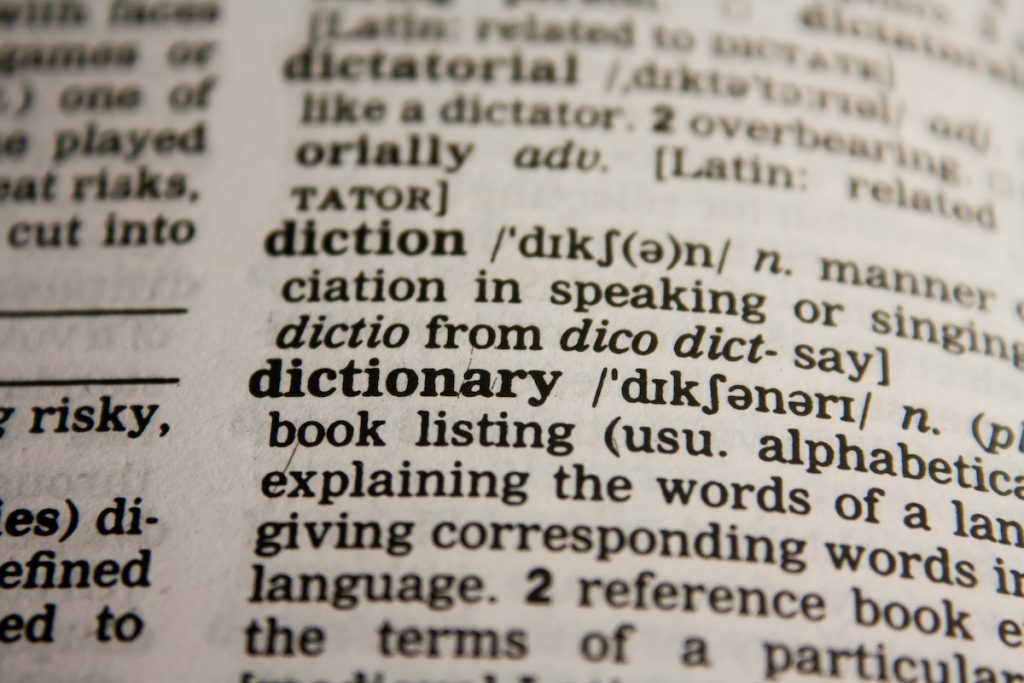
Beyond the Dictionary: 10 Ways Reading Can Unlock Extensive Knowledge
Do you still find yourself flipping through the pages of a dictionary in an attempt to expand your vocabulary? Well, it’s time to set aside…
Leave a Comment Cancel Reply
Your email address will not be published. Required fields are marked *
Save my name, email, and website in this browser for the next time I comment.
Need a free English consultation? Our experts will help within minutes 👉
Thanks! One of our experts will connect with you.
Understanding Transitional Words and Phrases

Transition words, also known as linking words or connectors, are words or phrases that create a smooth flow and logical progression in writing. They establish connections between sentences, paragraphs, and ideas, making the text more coherent and easier to follow.
The function and importance of transitions
Transition words serve several essential functions in writing. Firstly, they help guide the reader through the text by signaling shifts in ideas, relationships between concepts, and the overall structure of the content. These words act as signposts, allowing the reader to navigate through the writing more easily. Secondly, transitions enhance the clarity and organization of the writing, ensuring that ideas are presented in a logical and coherent manner. They help the reader understand the author’s intended message more effectively. Lastly, transitions contribute to the overall cohesion and fluency of the text, making it more engaging and enjoyable to read.
Transition words are not just helpful for readers; they also play a significant role in search engine optimization (SEO). While they are effective for a range of writing styles, such as ad copy and academic writing, their impact on SEO should not be underestimated. Transition words aid in creating a logical flow within a text, indicating various relationships such as sequence, contrast, cause and effect, and addition. This logical flow not only improves the readability and organization of your content but also enhances its engagement and navigability for both readers and search engines.
As you will see, the use of transitional words and phrases in your writing is vital for communicating concepts and arguments in a clear and effective manner. By employing these transitional devices, you can guide your readers through your content, making it easier for them to follow your ideas and grasp the overall message. This improved clarity and structure not only benefits your readers but also contributes to the success of your SEO efforts.
While transition words may not directly impact your SEO rankings, they indirectly influence your website’s visibility by enhancing the user experience. The readability and organization of your content are crucial factors that search engines consider when determining the relevance and usefulness of your website. By using transition words effectively, you can create an inviting and user-friendly environment that encourages readers to stay longer, explore further, and ultimately contribute to your website’s SEO success.
By employing these linguistic tools, you can improve the clarity, organization, and overall user experience of your content, making it more enticing and accessible for both readers and search engines. So, remember to incorporate transition words strategically in your writing, and reap the benefits of improved readability and SEO performance.
When to use transition words
Transition words should be used whenever there is a need to establish a connection or transition between ideas, sentences, or paragraphs. They are particularly useful in essays, research papers, and any other form of academic or professional writing. Transition words can also be employed in creative writing, speeches, and even everyday conversations to make the discourse more coherent and persuasive.
Both non-native speakers and native speakers could benefit from studying less frequent transition words. While it is commonly observed that non-native speakers struggle with knowing transition words, native speakers can also enhance their writing skills by familiarizing themselves with the less commonly used ones.
Types of transition words
Transition words are an essential part of writing as they help to establish connections and improve the flow of ideas. They can be classified into various categories based on their functions. Here are some of the most commonly used types of transition words:
Comparison transition words are used to highlight similarities and differences between ideas or concepts. Examples of comparison transition words include “similarly,” “likewise,” and “in comparison.”
Sequence/Time
Sequence or time transition words are used to indicate the order or sequence of events or ideas. They help to create a chronological structure in writing. Examples of sequence/time transition words include “first,” “next,” and “finally.”
Place transition words are used to indicate location or spatial relationships between ideas. They help establish a sense of setting or context. Examples of place transition words include “in the distance,” “beyond,” and “nearby.”
Summary transition words are used to provide a concise overview or summary of the main points or ideas discussed. They help to wrap up the content and emphasize the key takeaways. Examples of summary transition words include “in conclusion,” “to summarize,” and “overall.”
Examples transition words are used to illustrate or provide evidence for a point or idea. They help to support the writer’s argument or claims. Examples of examples transition words include “for instance,” “for example,” and “specifically.”
Cause/Effect
Cause and effect transition words are used to show the relationship between causes and their effects, or between actions and their consequences. They help to explain the reasons behind certain outcomes. Examples of cause/effect transition words include “because,” “as a result,” and “therefore.”
Emphasis transition words are used to stress or highlight a particular point or idea. They help to draw the reader’s attention to important information. Examples of emphasis transition words include “indeed,” “above all,” and “significantly.”
Contrast transitions
These words are used to highlight differences or contradictions between ideas. Examples include “however,” “although,” “nevertheless,” and “yet.”
Illustration transitions
These words are used to provide examples or clarify a point. Examples include “for example,” “such as,” “in other words,” and “to illustrate.”
Qualification/Concession
Qualification or concession transition words are used to introduce a contrasting or opposing viewpoint or to acknowledge potential limitations or exceptions to an argument. They help to add complexity and nuance to the writing. Examples of qualification/concession transition words include “however,” “on the other hand,” and “despite.”
By incorporating these different types of transition words into your writing, you can create a more cohesive and coherent piece of work. They not only make your writing easier to understand but also add depth and clarity to your ideas. So, next time you are writing, remember to make use of these transition words to enhance your writing skills.
Common mistakes writers make with transition words
While transition words are valuable tools in writing, they are often misused or overused. Some common mistakes to avoid include:
- Using too many transitions within a single sentence or paragraph, which can lead to confusion and a choppy flow.
- Using transitions incorrectly, such as using “however” instead of “moreover” to express addition.
- Not using transitions at all, resulting in a disorganized and disjointed text.
Make every transition a smooth one
To ensure smooth transitions in your writing, consider the following tips:
- Choose appropriate transitions based on the relationship between ideas.
- Use transitions sparingly and strategically, focusing on clarity and coherence.
- Read your writing aloud to identify any abrupt shifts or missing transitions.
- Revise and edit your work to refine the flow and coherence of your transitions.

50 Transition Words & Phrases Improve Your Writing
- First and foremost
- Furthermore
- In addition
- Additionally
- On the other hand
- Nevertheless
- Nonetheless
- In contrast
- Alternatively
- As a result
- Consequently
- Accordingly
- For example
- For instance
- In particular
- Specifically
- By and large
- Generally speaking
- To summarize
- In conclusion
Transition words play a crucial role in enhancing the coherence and readability of writing. By using them effectively, you can guide your readers through your ideas with ease, creating a more engaging and persuasive piece of work. So, remember to choose your transitions wisely and make every transition a smooth one!
Leave a Reply Cancel reply
Your email address will not be published. Required fields are marked *
Save my name, email, and website in this browser for the next time I comment.
Have a thesis expert improve your writing
Check your thesis for plagiarism in 10 minutes, generate your apa citations for free.
- Knowledge Base
- Sentence structure
- Transition Words & Phrases | List & Examples
Transition Words & Phrases | List & Examples
Published on 20 October 2022 by Jack Caulfield . Revised on 15 March 2023.
Transition words and phrases (also called linking words, connecting words, or transitional words) are used to link together different ideas in your text. They help the reader to follow your arguments by expressing the relationships between different sentences or parts of a sentence.
The proposed solution to the problem did not work. Therefore , we attempted a second solution. However , this solution was also unsuccessful.
For clear writing, it’s essential to understand the meaning of transition words and use them correctly.
Instantly correct all language mistakes in your text
Be assured that you'll submit flawless writing. Upload your document to correct all your mistakes.

Table of contents
When and how to use transition words, types and examples of transition words, common mistakes with transition words.
Transition words commonly appear at the start of a new sentence or clause (followed by a comma ), serving to express how this clause relates to the previous one.
Transition words can also appear in the middle of a clause. It’s important to place them correctly to convey the meaning you intend.
Example text with and without transition words
The text below describes all the events it needs to, but it does not use any transition words to connect them. Because of this, it’s not clear exactly how these different events are related or what point the author is making by telling us about them.
If we add some transition words at appropriate moments, the text reads more smoothly and the relationship among the events described becomes clearer.
Germany invaded Poland on September 1, 1939. Consequently , France and the United Kingdom declared war on Germany. The Soviet Union initially worked with Germany in order to partition Poland. However , Germany invaded the Soviet Union in 1941.
Don’t overuse transition words
While transition words are essential to clear writing, it’s possible to use too many of them. Consider the following example, in which the overuse of linking words slows down the text and makes it feel repetitive.
In this case the best way to fix the problem is to simplify the text so that fewer linking words are needed.
The key to using transition words effectively is striking the right balance. It is difficult to follow the logic of a text with no transition words, but a text where every sentence begins with a transition word can feel over-explained.
The only proofreading tool specialized in correcting academic writing
The academic proofreading tool has been trained on 1000s of academic texts and by native English editors. Making it the most accurate and reliable proofreading tool for students.

Correct my document today
There are four main types of transition word: additive, adversative, causal, and sequential. Within each category, words are divided into several more specific functions.
Remember that transition words with similar meanings are not necessarily interchangeable. It’s important to understand the meaning of all the transition words you use. If unsure, consult a dictionary to find the precise definition.
Additive transition words
Additive transition words introduce new information or examples. They can be used to expand upon, compare with, or clarify the preceding text.
Adversative transition words
Adversative transition words always signal a contrast of some kind. They can be used to introduce information that disagrees or contrasts with the preceding text.
Causal transition words
Causal transition words are used to describe cause and effect. They can be used to express purpose, consequence, and condition.
Sequential transition words
Sequential transition words indicate a sequence, whether it’s the order in which events occurred chronologically or the order you’re presenting them in your text. They can be used for signposting in academic texts.
Transition words are often used incorrectly. Make sure you understand the proper usage of transition words and phrases, and remember that words with similar meanings don’t necessarily work the same way grammatically.
Misused transition words can make your writing unclear or illogical. Your audience will be easily lost if you misrepresent the connections between your sentences and ideas.
Confused use of therefore
“Therefore” and similar cause-and-effect words are used to state that something is the result of, or follows logically from, the previous. Make sure not to use these words in a way that implies illogical connections.
- We asked participants to rate their satisfaction with their work from 1 to 10. Therefore , the average satisfaction among participants was 7.5.
The use of “therefore” in this example is illogical: it suggests that the result of 7.5 follows logically from the question being asked, when in fact many other results were possible. To fix this, we simply remove the word “therefore.”
- We asked participants to rate their satisfaction with their work from 1 to 10. The average satisfaction among participants was 7.5.
Starting a sentence with also , and , or so
While the words “also,” “and,” and “so” are used in academic writing, they are considered too informal when used at the start of a sentence.
- Also , a second round of testing was carried out.
To fix this issue, we can either move the transition word to a different point in the sentence or use a more formal alternative.
- A second round of testing was also carried out.
- Additionally , a second round of testing was carried out.
Transition words creating sentence fragments
Words like “although” and “because” are called subordinating conjunctions . This means that they introduce clauses which cannot stand on their own. A clause introduced by one of these words should always follow or be followed by another clause in the same sentence.
The second sentence in this example is a fragment, because it consists only of the “although” clause.
- Smith (2015) argues that the period should be reassessed. Although other researchers disagree.
We can fix this in two different ways. One option is to combine the two sentences into one using a comma. The other option is to use a different transition word that does not create this problem, like “however.”
- Smith (2015) argues that the period should be reassessed, although other researchers disagree.
- Smith (2015) argues that the period should be reassessed. However , other researchers disagree.
And vs. as well as
Students often use the phrase “ as well as ” in place of “and,” but its usage is slightly different. Using “and” suggests that the things you’re listing are of equal importance, while “as well as” introduces additional information that is less important.
- Chapter 1 discusses some background information on Woolf, as well as presenting my analysis of To the Lighthouse .
In this example, the analysis is more important than the background information. To fix this mistake, we can use “and,” or we can change the order of the sentence so that the most important information comes first. Note that we add a comma before ‘as well as’ but not before ‘and’.
- Chapter 1 discusses some background information on Woolf and presents my analysis of To the Lighthouse .
- Chapter 1 presents my analysis of To the Lighthouse , as well as discussing some background information on Woolf.
Note that in fixed phrases like “both x and y ,” you must use “and,” not “as well as.”
- Both my results as well as my interpretations are presented below.
- Both my results and my interpretations are presented below.
Use of and/or
The combination of transition words “and/or” should generally be avoided in academic writing. It makes your text look messy and is usually unnecessary to your meaning.
First consider whether you really do mean “and/or” and not just “and” or “or.” If you are certain that you need both, it’s best to separate them to make your meaning as clear as possible.
- Participants were asked whether they used the bus and/or the train.
- Participants were asked whether they used the bus, the train, or both.
Archaic transition words
Words like “hereby,” “therewith,” and most others formed by the combination of “here,” “there,” or “where” with a preposition are typically avoided in modern academic writing. Using them makes your writing feel old-fashioned and strained and can sometimes obscure your meaning.
- Poverty is best understood as a disease. Hereby , we not only see that it is hereditary, but acknowledge its devastating effects on a person’s health.
These words should usually be replaced with a more explicit phrasing expressing how the current statement relates to the preceding one.
- Poverty is best understood as a disease. Understanding it as such , we not only see that it is hereditary, but also acknowledge its devastating effects on a person’s health.
Cite this Scribbr article
If you want to cite this source, you can copy and paste the citation or click the ‘Cite this Scribbr article’ button to automatically add the citation to our free Reference Generator.
Caulfield, J. (2023, March 15). Transition Words & Phrases | List & Examples. Scribbr. Retrieved 29 April 2024, from https://www.scribbr.co.uk/academic-style/transition-words-examples/
Is this article helpful?

Jack Caulfield
Other students also liked, using conjunctions | definition, rules & examples, adverbial phrases (& clauses) | definition & examples, phrasal verbs | list, definition, examples & tips.

Awesome Resources for Creative Writing: Transition Words
March 13, 2017 By Andy Peloquin
- Addition/agreement -- In addition to, by the same token, as well as, furthermore, and moreover serve to reinforce or add on to the sentence.
- Opposition/contradiction– In spite of, instead, although, despite, but, and nevertheless can all indicate a shift in perspective or belief in the sentence.
- Condition/cause– Because of, while, due to, provided that, and in order to all show causes and conditions that link parts of a sentence together.
- Emphasis/example– For example, for this reason, chiefly, especially, to emphasize, in other words, and in general all support or emphasize the idea you are trying to communicate, highlighting them for the reader's attention.
- Summary/conclusion – As shown above, in summary/conclusion, to sum up, and for the most part are all used to close an idea or thought, or to sum up what was just said.
- Place/location – Near, above, beneath, beside, across, between, further, farther, and in the middle all help to qualify location in writing, and work together with time/sequence transitions to give the reader an understanding of the "where".
- Time/sequence – First, later, before, during, after, until now, by the time, occasionally, and from time to time all answer the "when" of the writing.
- Consequence/effect – Because, for, so, hence, and consequently explain the reason behind something or the consequence of the action.
33 Transition Words and Phrases
Transitional terms give writers the opportunity to prepare readers for a new idea, connecting the previous sentence to the next one.
Many transitional words are nearly synonymous: words that broadly indicate that “this follows logically from the preceding” include accordingly, therefore, and consequently . Words that mean “in addition to” include moreover, besides, and further . Words that mean “contrary to what was just stated” include however, nevertheless , and nonetheless .
as a result : THEREFORE : CONSEQUENTLY
The executive’s flight was delayed and they accordingly arrived late.
in or by way of addition : FURTHERMORE
The mountain has many marked hiking trails; additionally, there are several unmarked trails that lead to the summit.
at a later or succeeding time : SUBSEQUENTLY, THEREAFTER
Afterward, she got a promotion.
even though : ALTHOUGH
She appeared as a guest star on the show, albeit briefly.
in spite of the fact that : even though —used when making a statement that differs from or contrasts with a statement you have just made
They are good friends, although they don't see each other very often.
in addition to what has been said : MOREOVER, FURTHERMORE
I can't go, and besides, I wouldn't go if I could.
as a result : in view of the foregoing : ACCORDINGLY
The words are often confused and are consequently misused.
in a contrasting or opposite way —used to introduce a statement that contrasts with a previous statement or presents a differing interpretation or possibility
Large objects appear to be closer. Conversely, small objects seem farther away.
used to introduce a statement that is somehow different from what has just been said
These problems are not as bad as they were. Even so, there is much more work to be done.
used as a stronger way to say "though" or "although"
I'm planning to go even though it may rain.
in addition : MOREOVER
I had some money to invest, and, further, I realized that the risk was small.
in addition to what precedes : BESIDES —used to introduce a statement that supports or adds to a previous statement
These findings seem plausible. Furthermore, several studies have confirmed them.
because of a preceding fact or premise : for this reason : THEREFORE
He was a newcomer and hence had no close friends here.
from this point on : starting now
She announced that henceforth she would be running the company.
in spite of that : on the other hand —used when you are saying something that is different from or contrasts with a previous statement
I'd like to go; however, I'd better not.
as something more : BESIDES —used for adding information to a statement
The city has the largest population in the country and in addition is a major shipping port.
all things considered : as a matter of fact —used when making a statement that adds to or strengthens a previous statement
He likes to have things his own way; indeed, he can be very stubborn.
for fear that —often used after an expression denoting fear or apprehension
He was concerned lest anyone think that he was guilty.
in addition : ALSO —often used to introduce a statement that adds to and is related to a previous statement
She is an acclaimed painter who is likewise a sculptor.
at or during the same time : in the meantime
You can set the table. Meanwhile, I'll start making dinner.
BESIDES, FURTHER : in addition to what has been said —used to introduce a statement that supports or adds to a previous statement
It probably wouldn't work. Moreover, it would be very expensive to try it.
in spite of that : HOWEVER
It was a predictable, but nevertheless funny, story.
in spite of what has just been said : NEVERTHELESS
The hike was difficult, but fun nonetheless.
without being prevented by (something) : despite—used to say that something happens or is true even though there is something that might prevent it from happening or being true
Notwithstanding their youth and inexperience, the team won the championship.
if not : or else
Finish your dinner. Otherwise, you won't get any dessert.
more correctly speaking —used to introduce a statement that corrects what you have just said
We can take the car, or rather, the van.
in spite of that —used to say that something happens or is true even though there is something that might prevent it from happening or being true
I tried again and still I failed.
by that : by that means
He signed the contract, thereby forfeiting his right to the property.
for that reason : because of that
This tablet is thin and light and therefore very convenient to carry around.
immediately after that
The committee reviewed the documents and thereupon decided to accept the proposal.
because of this or that : HENCE, CONSEQUENTLY
This detergent is highly concentrated and thus you will need to dilute it.
while on the contrary —used to make a statement that describes how two people, groups, etc., are different
Some of these species have flourished, whereas others have struggled.
NEVERTHELESS, HOWEVER —used to introduce a statement that adds something to a previous statement and usually contrasts with it in some way
It was pouring rain out, yet his clothes didn’t seem very wet.
Word of the Day
See Definitions and Examples »
Get Word of the Day daily email!
Games & Quizzes

Usage Notes
Prepositions, ending a sentence with, hypercorrections: are you making these 6 common mistakes, a comprehensive guide to forming compounds, can ‘criteria’ ever be singular, singular nonbinary ‘they’: is it ‘they are’ or ‘they is’, grammar & usage, primary and caucus: what is the difference, words commonly mispronounced, merriam-webster’s great big list of words you love to hate, what’s the difference between ‘hillbilly’ and ‘redneck’, more commonly misspelled words, 12 words for signs of spring, 12 more bird names that sound like insults (and sometimes are), 13 unusually long english words, the words of the week - apr. 26, 9 superb owl words.
Table of Contents
Ai, ethics & human agency, collaboration, information literacy, writing process, transitions – transition words – transitional phases.
- © 2023 by Joseph M. Moxley - University of South Florida , Barbara McLain - The Out-of-Door Academy
Transitions are a lifeline for readers, listeners, users —a kind of conceptual superglue . Transition words and traditional phrases are crucial to helping audiences keep track of the author's reasoning and purposes for writing. Learn to identify when transitions are warranted in your work and the work of others. Distinguish between effective and ineffective transitions.

What are Transitions? Transition Words? Transition Phrases?
Transitions, Transition Words , Transitional Phases—these terms concern authors’ efforts to design the flow of information in a text in ways that promote clarity , brevity , simplicity , flow , unity for readers, listeners, users .
Accomplished writers understand interpretation is challenging. They understand readers can lose track of the big picture—the writer’s purpose , thesis , research question . Thus, when revising and editing , writers are careful to check the flow of information across words , sentences , paragraphs . They seek to identify and rewrite choppy spots in their writing when readers ask, “Why am I being given this information? So What? How does this relate to what’s been said thus far?”
Transitions refers to
- the act of shifting the focus in discourse from one idea, process, state, experience to something new
- the convention that writers address information literacy practices and perspectives when they cite textual evidence or empirical evidence
- efforts to clarify a text’s organizational schema,
Transition Words & Phrases are words and phrases (aka signs or signposts) that writers and speakers use to help their readers, listeners, or users understand the flow of information across a text .
Transitional Words refers to elements of spoken and written language (e.g., words, phrases, sentences, paragraphs, and sections) that authors use to help audiences understand the flow of information across a text .
- Transitions may be referred to as sticky points, wounds, seques, gaps
- Transition Words may also be referred to as transitional language , linking language, explanatory language, metalanguage, pivoting, signposting
Related Concepts: Communication ; Information Architecture ; Organization ; Organizational Schema; Rhetorical Analysis ; Rhetorical Reasoning ; Unity
Why Do Transitions Matter?
For readers, listeners, users , transitions are a lifeline —a kind of conceptual superglue . Transition words are crucial to helping audiences keep track of the author’s reasoning and purpose for writing.
At any given moment, people experience a tsunami of information coming at them at warp speed. When reading or listening, people may be distracted by any number of other things—an email, a plane flying overhead, a social media post, a poignant memory, a stock market crash. Their own personal concerns or a nudge from social media may get them off task in a jiffy.
Writers and speakers use transitions to keep the audience’s focus on their narrative , thesis , research question , hypothesis.
Function of Transition Words & Transitional Phrases
Transition words and transition phrases may be categorized by their rhetorical function —aim of discourse, as illustrated in Table 1 below.

Best Transition Words for Essays
The best transition words are the ones that best match your rhetorical situation .
In order to identify the best transition words for an essay you are writing, you should first engage in rhetorical analysis and rhetorical reasoning . Subsequently, you can then make rhetorically informed decisions regarding the appropriate persona , tone , and voice you should adopt when you begin your composition .
Sample Questions for Rhetorical Analysis of Transitions
In order to select appropriate transitions and transitional words for your texts , engage in rhetorical analysis . Ask yourself,
- What is my purpose (aka aim) ? What am I attempting to accomplish?
- If so, you may not even need transitions.
- Then you’ll need extensive transitional language to help your readers follow your reasoning.
- Are there any genre considerations or media considerations that inform your readers’ expectations regarding effective or ineffective uses of transitional language ?
Academic Writing Prose Conventions
Transition words in academic essays and academic writing in general tend
- to use formal diction .
- Academic essays often express transitions in paragraph form at the beginning of texts and interspersed between major sections
- to reflect the information literacy perspectives & practices of their intended audiences.
Template for Transitions in Academic Writing
Below are examples of common transitions in academic writing genres.
Professional Writing Prose Conventions
Transition words in professional writing (aka workplace writing ) are similar to those in academic writing . However, there are a few distinctions: workplace writing tends to rely more on headings and visual language than rely on paragraph-style transitions like those used in academic writing.
Transitions & Invention

For writers, transitions across topics can spark invention . Sometimes when revising, when looking in between sentences and paragraphs to check them for clarity , writers identify breakdowns in their reasoning or gaps in scholarly conversations or discover entirely new things to say.
How to Edit Transitions & Transition Words
Teachers and critic s write Transition? on texts when they
- They don’t understand why they are being told what they are being told.
- believe a t ransitional word or a transitional phrase is superfluous or used incorrectly (see Brevity )
You will find it helpful to examine your use of transition words if you have been told your organization needs work or that your writing is awkward or choppy .
Step 1: Rhetorical Analysis
First, make sure your transitions are appropriate for the rhetorical situation you are addressing. For example, if you are addressing a loved one in a personal note, you would want to use “also” instead of “moreover.”
Check, in particular, the tone and diction level of your transition words.
Step 2: Textual Analysis
When you revise , edit , or proofread your documents, you should consider whether or not you have provided sufficient transition s and transition words .
- between and within sentences : Transitional words or phrases are used to create connections between sentences, as well as within sentences; both uses enhance the progression of ideas at the sentence level .
- between paragraphs : Transitional sentences are used to create a bridge between paragraphs. These sentences should provide a summary of the main idea of one paragraph and give the reader a clue as to what is coming in the next paragraph (Internal link to: relate paragraphs logically to previous paragraph(s).
- between sections : Transitional paragraphs are used in longer works to summarize the discussion of one section and introduce the reader to the concept(s) presented in the next section.
Also, be sure to double check that you have avoided tedious repetition. Remember, when it comes to transition words, less is more. When possible, you want to vary your transition words.
Example of Unvaried transitional language that creates a primer-like style:
We went to the national mall. Then we visited the Air and Space Museum. Then we stopped for lunch at Jaleo.
Varied transitional language : To start the day, we went to the national mall. After a stroll around the reflecting pool, we visited the Air and Space Museum. When we couldn’t walk another step, we stopped at Jaleo for lunch.
Related Concepts
Transitions, Transition Words, Transitional Language — these concepts are intertwined with information architecture , organizational schema (aka organizational scaffolding), and recent research on cognitive development and learning science theory.
Transitions & Transition Words are a major textual attribute of a reader-based prose style , an academic prose style , and a professional writing prose style (aka workplace writing style).
In contrast, writer-based prose lacks needed transitions and transition words .

Brevity - Say More with Less

Clarity (in Speech and Writing)

Coherence - How to Achieve Coherence in Writing

Flow - How to Create Flow in Writing

Inclusivity - Inclusive Language

The Elements of Style - The DNA of Powerful Writing

Suggested Edits
- Please select the purpose of your message. * - Corrections, Typos, or Edits Technical Support/Problems using the site Advertising with Writing Commons Copyright Issues I am contacting you about something else
- Your full name
- Your email address *
- Page URL needing edits *
- Phone This field is for validation purposes and should be left unchanged.
Other Topics:

Citation - Definition - Introduction to Citation in Academic & Professional Writing
- Joseph M. Moxley
Explore the different ways to cite sources in academic and professional writing, including in-text (Parenthetical), numerical, and note citations.

Collaboration - What is the Role of Collaboration in Academic & Professional Writing?
Collaboration refers to the act of working with others or AI to solve problems, coauthor texts, and develop products and services. Collaboration is a highly prized workplace competency in academic...

Genre may reference a type of writing, art, or musical composition; socially-agreed upon expectations about how writers and speakers should respond to particular rhetorical situations; the cultural values; the epistemological assumptions...

Grammar refers to the rules that inform how people and discourse communities use language (e.g., written or spoken English, body language, or visual language) to communicate. Learn about the rhetorical...

Information Literacy - Discerning Quality Information from Noise
Information Literacy refers to the competencies associated with locating, evaluating, using, and archiving information. In order to thrive, much less survive in a global information economy — an economy where information functions as a...

Mindset refers to a person or community’s way of feeling, thinking, and acting about a topic. The mindsets you hold, consciously or subconsciously, shape how you feel, think, and act–and...

Rhetoric: Exploring Its Definition and Impact on Modern Communication
Learn about rhetoric and rhetorical practices (e.g., rhetorical analysis, rhetorical reasoning, rhetorical situation, and rhetorical stance) so that you can strategically manage how you compose and subsequently produce a text...

Style, most simply, refers to how you say something as opposed to what you say. The style of your writing matters because audiences are unlikely to read your work or...

The Writing Process - Research on Composing
The writing process refers to everything you do in order to complete a writing project. Over the last six decades, researchers have studied and theorized about how writers go about...

Writing Studies
Writing studies refers to an interdisciplinary community of scholars and researchers who study writing. Writing studies also refers to an academic, interdisciplinary discipline – a subject of study. Students in...
Featured Articles

Academic Writing – How to Write for the Academic Community

Professional Writing – How to Write for the Professional World

Credibility & Authority – How to Be Credible & Authoritative in Speech & Writing
Backlink building. Content marketing. Technical optimizations. Wherever your SEO strategy goes, Search Atlas has the tools.
- Site Auditor
- Local SEO Software
- On-Page Audit Tool
- Site Explorer
- Enterprise SEO Software
- Backlink Analyzer
- Keyword Researcher
- Content Planner
- Blog Idea Generator
- Topical Map Generator
- SEO Content Assistant
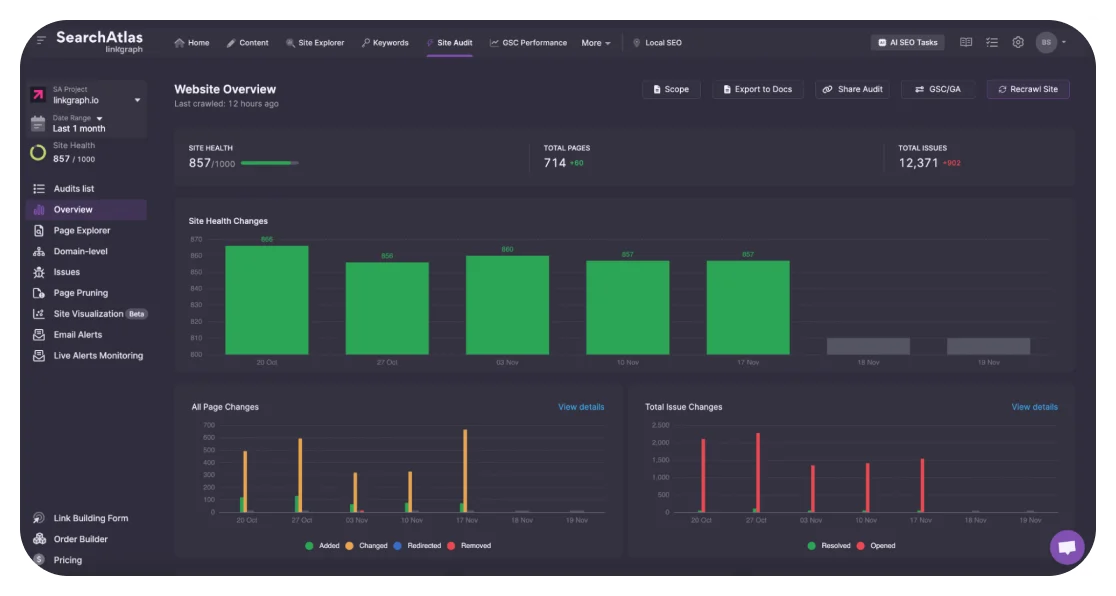
Get detailed reports on the technical SEO health of any website.
Get in-depth insights on organic traffic, keywords, and backlinks for any website or url.
Create 10X more SEO content for your agency clients and drive organic traffic at warp speed.
Audit the content quality of your clients’ web pages and get immediate feedback for improvement.
Enter homepage URLs and get DA scores with our dashboard’s DA Checker or try the demo tool below.
Enter a keyword and get keyword metrics like search volume, cost-per-click, and Keyword Difficulty.
Enter your target keyword and generate blog ideas in seconds.
- Search Atlas vs. Ahrefs
- Search Atlas vs. SEMRush
- Search Atlas vs. Surfer SEO
Enhance Your Writing: Mastering Transition Words
Search atlas.
- November 29, 2023
- read 18 mins

Seamless Writing Flow: The Importance of Transition Words and Their Usage
Seamlessly connecting thoughts, Transition words serve as bridges that carry the reader from one idea to the next, enhancing the flow and coherence of prose.
They are the critical elements that ensure the text maintains a readable and persuasive quality.
Whether in crafting an advertisement or articulating a complex argument for an academic audience, these linguistic devices play a foundational role.
By mastering their use, writers, speakers, and instructors can significantly improve the clarity and persuasiveness of their communication.
Keep reading to discover how strategic placement of transition phrases can transform your writing skills.
Key Takeaways
- Transition Words Are Essential Linguistic Devices Serving as Bridges Between Sentences and Enhancing Readability
- Strategic Deployment of Transition Words Is Crucial for Maintaining Momentum and Cohesiveness in Writing
- Tailoring Transition Word Usage to the Genre and Writing Style Enhances Narrative Flow and Reader Engagement
- Leveraging Tools Like Search Atlas on-Page Audit Tool Can Refine the Use and Optimization of Transition Words in Content
- Peer Review and Iterative Rewriting Are Important for Improving the Transitional Flow in Writing
Understanding Transition Words and Their Functions
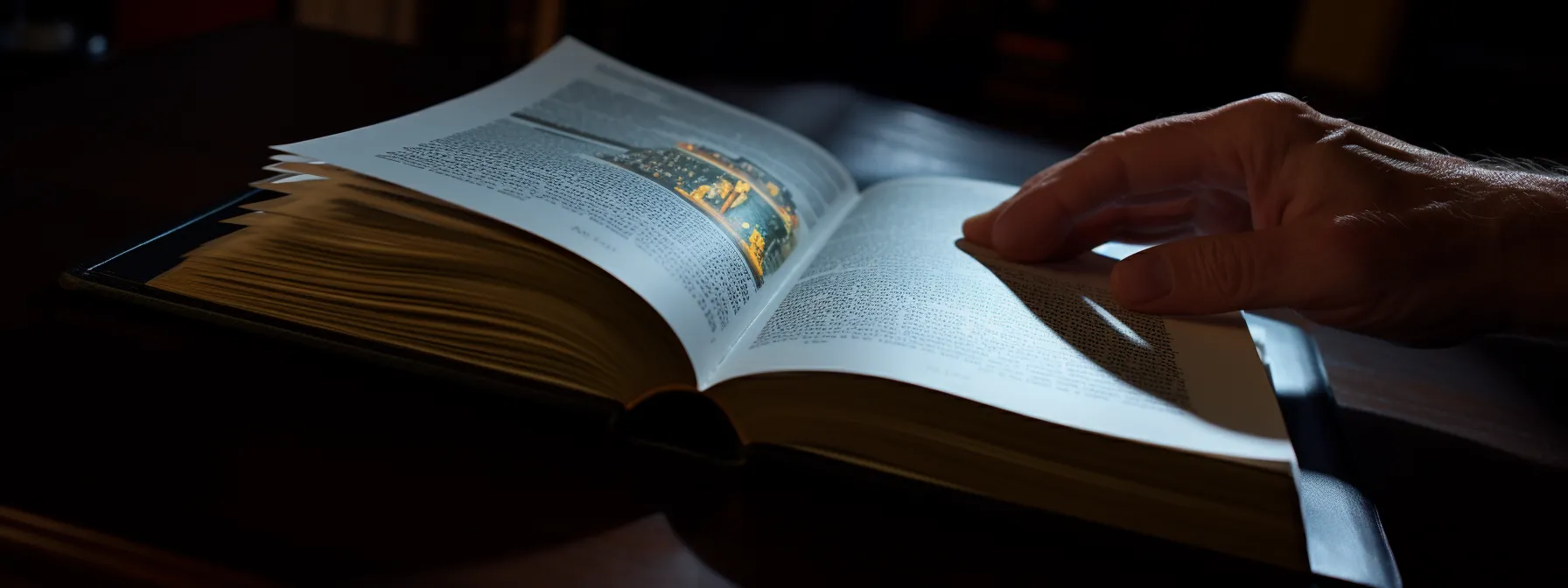
Transition words are essential tools that an author employs to guide readers through their text, effectively serving as bridges between sentences and ideas, which enhances the narrative flow.
These linguistic devices act as connectors, knitting paragraphs together to ensure that prose is coherent and comprehensive.
They play a significant role in signifying the relationship between thoughts, thereby augmenting readability and preventing jarring disruptions that may hinder the audience’s understanding.
For writers and their readers, the judicious use of transition phrases does not only polish the writing but also helps convey a clear message, fostering a better connection with the intended participants in any written dialogue.
Define Transition Words and Their Role in Writing
Transition words serve as the cornerstone of fluent writing, holding a critical place within the author’s toolkit. They facilitate the speaker’s intention to clearly articulate the progression and connections between arguments, ensuring the audience remains engaged and the message is effortlessly conveyed.
Used effectively, transition phrases become the linguistic glue that binds disparate elements of a text together, creating a seamless experience for readers. These words uphold the structure of discourse, making the transition from one concept to another a smooth journey for any reader delving into the writer’s narrative.
Illustrate How Transition Words Act as Writing Connectors
Transition words serve a key role in coherence, offering a pathway for the reader’s journey through a text. They equip the writer with a versatile set of tools designed to connect sentences and ideas with clarity and purpose.
By implementing transition phrases, authors establish clear reference points within their narrative, allowing thoughts to merge and separate with precision and harmony. Such elements turn an otherwise fragmented series of statements into a fluid and engaging textual conversation:
Writing connectors, often overlooked yet pivotal, are the sinew that binds the content’s muscle to the skeleton of the main argument. Such connections not only propel the narrative forward but also elevate the user’s cognitive experience by providing a clear, logical progression of information.
Recognize the Connection Between Thoughts and Readability
The symbiosis between the lucidity of ideas and the ease of reading is undeniable; transition words are the underpinnings of this relationship. They elevate the prose, stitching each argument to the next, allowing readers to grasp the text’s essence without obstruction.
Authors who masterfully weave transition phrases into their work enhance the readability of the content, enabling the audience to track the progression of thoughts effortlessly. The effective use of these linguistic devices is pivotal in transforming a labyrinth of words into an intuitive narrative that captivates and informs.
Discuss the Benefits of Using Transitions for Writers and Readers
For writers, transition words are akin to a master painter’s stroke, bridging one section to another to create a coherent picture. These linguistic tools ensure their message resonates clearly, reducing the cognitive load on readers, who can then navigate the narrative with enhanced understanding.
Readers benefit significantly from the adept use of such connectors, as they provide clear signposts throughout the text. This clarity fosters deeper engagement, allowing readers to absorb and retain information with greater efficacy, thus amplifying the overall impact of the written word.
The Mechanics of Transition Words in Sentences

Writing with coherence and precision is not just about stringing words together; it involves crafting sentences that flow naturally and convey meaning without ambiguity.
The mechanics of incorporating transition words into a text are foundational to achieving this fluidity.
They are the instruments that shape the cadence of writing, allowing a seamless transition between thoughts, which is central for maintaining the reader’s interest and understanding.
Transition words are more than mere ornamentation; they are the threads that weave together a tapestry of ideas into an intelligible whole.
The following sections will dissect the strategic placement of these connectors, elucidate how they can fortify sentence formation, offer guidance to evade common blunders in their application, and refine the skill of blending subtle transitions into complex constructs.
Analyze the Placement and Impact of Transition Words
The strategic placement of transition words is pivotal to the momentum and clarity of an article or essay. They act as critical junctures, signifying to the reader both the conclusion of one thought and the introduction of the next, thus maintaining a continuous stream of comprehension.
When deployed effectively, these connectors amplify the impact of the text, reinforcing the author’s intent and ensuring each transition enhances the communication rather than distracting from it. Their proper use in sentences serves not only to direct the reader through the narrative but also to underscore the overall cohesion of the document.
Developing a Cohesive Sentence Structure With Transitions
Developing a cohesive sentence structure with transitions is not merely an exercise in ornamental writing; it is a fundamental aspect of effective communication. The adept use of these linguistic cues ensures each sentence naturally segues into the next, maintaining a coherent thread throughout the text:
By interlacing sentences with appropriate transition words, the text becomes more than a mere collection of individual statements. It evolves into a harmonious cascade of ideas that guides and informs the reader, exemplifying clarity and thought progression that resonate with the intended audience.
Tips to Avoid Common Mistakes While Using Transition Words
When crafting a narrative, the misuse of transition words can disrupt the rhythm of writing and impede reader understanding. One common pitfall is overuse, leading to an excessive and cumbersome texture of the text. To avoid this, writers should ensure that transition words are applied sparingly and only when they add genuine value to the clarity and flow of the prose.
Another oversight involves the haphazard insertion of such words, which can result in a disjointed or contradictory narrative. It’s essential that authors choose transitions that accurately reflect the relationship between ideas, thereby maintaining the integrity and coherence of their message:
Strict attention to context and the logical sequence of thought will prevent the employment of contradictory or misleading transitions. By focusing on accurate and purposeful use, authors enhance their writing’s effectiveness, ensuring that the audience traverses the text with ease and understanding.
Practice the Art of Subtle Transitions in Complex Sentences
The mastery of subtle transitions in complex sentences represents an advanced technique where the author carefully aligns transitional phrases to enhance the intricate nature of the prose. Crafting such sentences demands a nuanced understanding of both the content and the various transition options at one’s disposal, ensuring the readers find themselves navigating through rich, multi-layered statements with an inherent ease.
Intricate sentence constructions benefit from transitions that do not overshadow the content but rather complement the text’s depth. Authors perfect this art through the deliberate selection of understated yet effective words, which act as unobtrusive guides, leading the audience with a gentle hand through a sophisticated argument or narrative.
Why Transition Words Are Essential for Reader Engagement

Engaging readers in the narrative journey and simplifying complex ideas into digestible pieces marks the essence of skilled writing.
Transition words are the invisible threads that seamlessly stitch these pieces together, guiding the reader across the terrain of an argument with ease.
This section investigates how these linguistic signposts shape the perception of text, offering a roadmap for audiences as they navigate through the logical structure crafted by writers.
Exploring the reader’s experience and uncovering the psychological nuances of transitions uncovers their profound influence on comprehension and retention—key factors in maintaining reader engagement and delivering a clear message.
Explore Reader’s Perspective on Text With Transitions
From the reader’s vantage point, text interspersed with transition words provides a guided exploration through the narrative landscape. These signifiers function not merely as pavement marks on the reading journey but also as the craft that carries the reader across the river of discourse without any need for mental paddling or backtracking.
The cognitive load is noticeably reduced when transition words are present, allowing readers to allocate more mental resources to understanding and engaging with the content. This linguistic approach creates a sense of ease and continuity, which is pivotal in sustaining attention and interest:
- Transition words serve as helpful signposts, leading the reader through the message being conveyed.
- They reduce the cognitive effort required to make sense of the narrative’s direction.
- By offering clarity, transitions encourage deeper immersion and a more meaningful connection with the content.
How Transition Words Guide Readers Through Your Argument
Transition words are the unsung heroes that guide readers through the labyrinth of an author’s argument with deftness and precision. They are the conduits that facilitate a reader’s journey from one idea to the next, solidifying the connection and enhancing the persuasiveness of the argument.
Employing transition words strategically within an argument acts as a map for readers, ensuring they follow the intended path without getting lost in a maze of complexity:
By deftly stitching sentences and ideas together, these linguistic signposts support the writer’s main premise, ensuring the audience can perceive the cohesive structure of the discourse and the subtleties of the reasoning presented.
The Psychological Effect of Smooth Transitions on Comprehension
The deft insertion of transition words in writing can significantly influence comprehension, operating at a subtle psychological level. By providing a logical structure to the flow of text, transitions enable the reader to process information with greater ease, assisting in the buildup of a coherent mental model of the argument presented.
Smooth transitions serve not as stark signposts but gentle cues within the narrative, bolstering the reader’s cognitive journey. Such linguistic finesse paves the way for improved retention of information, as the brain appreciates the minimally required mental exertion to link concepts cohesively.
Different Categories of Transition Words and Their Uses

Embarking upon the intricate dance of crafting written material that resonates with the target audience involves an understanding of the nuances of language.
Just as a conductor skillfully directs an orchestra to produce harmonious melodies, a proficient writer must strategically employ transition words to sculpt a seamless flow of ideas, connecting threads of thought into a cohesive narrative fabric.
This subsection delves into the various categories of transition words, revealing their unique functions and highlighting when to use additive, adversative, causal, and sequential transitions.
It also provides insights into selecting the appropriate transition category that elegantly complements and enhances the message within your text, ensuring that each word performs its role with precision and supports the overarching narrative journey that captivates and informs the reader.
Introduction to Various Types of Transition Words
Transition words are often likened to a conductor’s baton, orchestrating the flow of a piece, ensuring each section moves in harmony with the next. Varied in their function, these linguistic tools are categorized by the nature of the connection they establish, whether it be to add information, contrast ideas, illustrate a cause and effect, or demonstrate a sequence.
Each category of transition words provides unique value within the narrative, helping to convey complex thoughts with clarity and grace. Expert writers leverage these categories to enhance the logical structure of their text, guiding readers through a smooth and engaging journey from introduction to conclusion, effectively communicating their intended message.
When to Use Additive, Adversative, Causal, and Sequential Transitions
Understanding when to use different categories of transition words can elevate one’s writing from simple text to a finely crafted piece. Additive transitions such as “furthermore,” “also,” and “in addition,” are utilized when the author seeks to present supplementary ideas or reinforce a point. Conversely, adversative transitions like “however,” “on the contrary,” and “nevertheless,” signal a shift to a contrasting argument or concede a point while introducing a counterargument.
Causal transitions like “because,” “thus,” and “as a result,” shine in scenarios where cause-and-effect relationships are being explored, connecting the rationale to its consequence: As strategic factors come into play during a campaign, Search Atlas, with its comprehensive tools, benefits digital marketers. Sequential transitions, evidenced by terms such as “firstly,” “subsequently,” “finally,” are crucial in outlining a series of events or steps, allowing the audience to follow the structured progression of concepts or instructions: Leveraging Search Atlas begins with keyword research , followed by a review of competitive landscapes via Site Explorer , culminating in content optimization for peak performance.
Selecting the Appropriate Transition Category for Your Text
Selecting the right transition word category hinges upon the desired impact on the reader and the nature of the content being presented. Writers must be mindful of the need to maintain textual harmony while delivering precise enhancements to the narrative. This selection process is particularly crucial within platforms such as Search Atlas, where content must be optimized for both SEO and user engagement, presenting complex information with clarity and logical connectivity.
- Identify the nature of the relationship between the ideas you wish to connect.
- Determine if you are adding, contrasting, showing cause and effect, or sequencing information.
- Select a word from the transition category that accurately conveys the relationship and adds to the coherence of the text.
Mastering the art of choosing the most fitting transition category ensures each statement in a text flows intuitively into the next. The writer’s task is to weave these linguistic elements seamlessly into the fabric of their prose, fortifying the structure of their argument and enhancing the readability for the audience. Such strategic utilization of transition words within an SEO dashboard like Search Atlas can elevate the content’s effectiveness and drive better digital marketing results.
Enhancing Narrative Flow With Strategic Transition Placement

The artful deployment of transition words is a crucial element in curating narratives that resonate with readers, fostering a seamless journey through the landscapes of thought and reason.
As authors piece together their stories, the subtle application of these linguistic constructs shapes the very backbone of effective communication.
Transition words give life to the written word, driving the trajectory of the narrative forward and imbuing paragraphs with the force necessary to propel the story’s progression.
With an appreciation for the nuanced role of transition words, the following section elucidates on the intricacies of crafting narratives, structuring impactful paragraphs, and harnessing these words as vital catalysts for advancing the storyline.
Crafting Narratives With Effective Transition Word Use
When narrative coherence is paramount, the strategic use of transition words becomes indispensable. Authors who skillfully bend these linguistic tools to their will can weave a tale that flows unhindered, moving readers through a progressive storyline that’s as engaging as it is logical.
Effective transition word use in crafting narratives allows for the sculpting of text that breathes, with each sentence gracefully leading into the next. This practice ensures that the narrative maintains momentum, compelling the reader forward in an almost invisible dance choreographed by the writer’s deft hand.
Structuring Paragraphs for Maximum Impact
The arrangement of paragraphs is more than just a structural necessity; it serves as a pivotal force in the narrative’s propulsion. Crafted with a keen understanding of transition placement, paragraphs become impactful by leading readers through a logical sequence of ideas: each assertion strengthens the preceding one, and gently foreshadows what is to come, thereby enhancing the reader’s engagement.
- Transition words initiate the momentum of each paragraph, providing clear signals of the narrative movement from one point to the next.
- Strategic execution of transition words ensures each paragraph encapsulates a complete and coherent thought, contributing to the overarching theme of the text.
- The careful selection and placement of transitional elements yield paragraphs that not only inform but also persuade, guiding the reader to desired conclusions.
By employing transitions meticulously within paragraphs, the writer can dictate the rhythm of the reader’s experience, producing content with consistent clarity and a robust communicative impact. This control is akin to an invisible hand, gently guiding readers, fostering comprehension, and ensuring that the narrative leaves a lasting impression, underpinning the seamless flow of the written word.
Transition Words as the Driving Force for Story Progression
Transition words are the pivotal gears within the mechanism of storytelling, ensuring that every narrative turn is smooth and purposeful. In the realm of story progression, they deftly maneuver readers through the unfolding plot, connecting the dots between scenes and sentiments, and providing the momentum that drives the tale onward.
Adept writers utilize these linguistic catalysts to steer their narrative, ensuring a constant forward motion that mirrors the natural thought process of the reader. The skillful application of transition words breathes life into the text, making each progression in the story feel both inevitable and effortless to the readers as they travel from beginning to end.
Mastering the Use of Transition Words for Clearer Writing

The mastery of transition words is a pivotal component in the art of crafting prose that is both clear and resonant.
As authors fine-tune their writings, a diverse transition word vocabulary can be a powerful asset, lending depth and finesse to their textual orchestrations.
Techniques for weaving these words seamlessly into the fabric of their sentences and paragraphs become invaluable, enhancing the natural flow of their narratives.
By regularly engaging in exercises and applying practical strategies within their daily writing endeavors, professionals can fortify their use of transition words, transforming even the most intricate concepts into lucid, digestible content that captivates and informs the reader, while maintaining a graceful continuity from one thought to the next.
Steps to Broaden Your Transition Word Vocabulary
To enhance one’s writing repertoire with a dynamic range of transition words, engaging in targeted activities, such as analyzing influential texts and scrutinizing the contextual usage of transitions by adept authors, can be immensely beneficial. This practice not only reveals the diversity within language but also underscores the subtle nuances that make certain transition words more suitable for particular contexts, equipping writers with a broader linguistic palette.
Incorporating diverse transition words into daily writing endeavors encourages adaptability and creativity, fostering a writer’s ability to align vocabulary with the intended tone and narrative flow. Regular experimentation with new and less familiar transitions can break monotonous patterns and invigorate writing with fresh connections, thus sharpening the writer’s skill in constructing clear, engaging, and coherent prose.
Techniques for Integrating Transition Words Naturally
Effortless integration of transition words fosters a natural reading experience, and writers can achieve this by prioritizing context. Transition words should seamlessly relate to the content at hand; their purpose is to act not as stand-alone elements, but as threads weaving through the narrative, enhancing connections between thoughts. Careful consideration of the logical flow within sentences ensures that transitions support the text’s continuity without drawing undue attention to themselves.
In the quest for fluidity, employing transitions that mirror conversational language can significantly improve a paragraph’s readability. Writers adept in the art of clear communication select transition words that echo the nuanced transitions of verbal exchanges, subtly guiding the reader through the narrative journey. By emulating spoken language, the text maintains a dynamic rhythm that resonates authentically with the reader, establishing a stronger bond between the author’s intent and the audience’s comprehension.
Exercise and Application Strategies for Everyday Writing
Exercise and application strategies are vital in mastering the everyday use of transition words. Consistent practice through writing drills that focus on various types of transitions can significantly enhance an author’s skill in creating fluid and coherent content. To achieve this, one might engage in structured exercises that target specific categories of transition words, allowing for a deliberate and focused approach to their integration.
Professionals recommend an intentional application methodology wherein one consciously deploys transition words in their everyday writing tasks, from emails to project reports. This embeds the practice into the writer’s natural style, fostering effortless application in more formal writing endeavors. To aid this process, creating personalized checklists of transition words and their functions can serve as handy references during the drafting stage:
Transition Words in Different Writing Genres and Styles

The strategic application of transition words vastly differs across various genres and styles of writing, reflecting the unique demands and audience expectations of each form.
Academic writing often commands a formal and precise use of transitions to delineate arguments and connect evidence.
In business communications, clarity and conciseness take precedence, utilizing transitions that facilitate swift comprehension and call to action.
Meanwhile, creative writing allows for a more flexible approach, embracing transitions that flow naturally and embellish the narrative.
With the understanding that genre and writing voice dictate the selection and implementation of these pivotal words, this section will explore how to tailor transition usage effectively, ensuring that each written work resonates with its intended genre and authentically represents the author’s voice.
Adapt Transition Words to Fit Academic, Business, and Creative Writing
In the academic sphere, the deployment of transition words must mirror the rigidity and analytical depth of scholarly discourse. Precision in this context is paramount; academic writers select transitions that denote clear relationships between propositions, lending credence and cohesion to the meticulously structured arguments that define this genre.
Conversely, in the fast-paced environment of business communications, transitions are chosen for their ability to streamline thought and promote action. Business writers often favor succinctness, opting for transitions that clarify and condense rather than elaborate, ensuring that the primary message remains in sharp focus amidst the practical context of business objectives.
Genre-Specific Transitions and Their Influence on the Text
The deliberate selection of genre-specific transitions can greatly influence the textual landscape, setting the tone and cementing coherence within a given body of work. In academic writing, methodically chosen transitions such as “consequently” or “therefore” signal the logical flow of argumentation, bolstering the evidential structure that is the bedrock of scholarly discourse.
In creative literature, transitions like “meanwhile” and “suddenly” punctuate the narrative, enhancing the reader’s journey through vivid storylines and character developments. These stylistic choices act as conduits for the reader’s imagination, providing rhythm and pacing that prompt emotional responses appropriate to the unfolding plot, reflecting the artful craft of the author.
Customizing Transition Word Choice to Match Your Writing Voice
Selecting the ideal transition words to align with one’s authorial tone is a crucial aspect of tailoring content to maintain authenticity and voice consistency. Writers deftly balance the formality or creativity of their language with transitions that echo their unique writing style, thereby preserving the integrity of their personal or branded voice within their prose.
Cognizant of the nuanced inflections that characterize their writing voice, authors carefully choose transition words that resonate with their narrative persona. This precision enhances the reader’s experience, ensuring that the content does not feel disjointed but rather flows smoothly, reflecting the writer’s distinctive stylistic nuances.
Evaluating Your Use of Transition Words Through Editing

In crafting the tapestry of text that resonates with one’s readership, it is imperative to reflect on the delicate interplay of transition words deployed throughout the narrative.
Experts in the field of writing emphasize the critical step of reviewing and refining these elements through the editorial process, ensuring a seamless flow of thoughts and ideas.
This subsection unfolds the various methodologies available to writers, aiming to objectively assess and enhance the utilization of transition words.
Embracing modern tools and leveraging peer insights, authors can meticulously polish transitional flow, elevating the quality of their manuscripts to meet the highest standards of clarity and coherence.
Methods to Objectively Review Transition Usage in Writing
In the meticulous editing process, writers can deploy various techniques to objectively assess the use of transition words, ensuring that each serves a clear and functional purpose. A common method includes reading the text aloud, which allows the writer to discern the natural flow and detect any abrupt or awkward transitions that may disrupt the narrative rhythm.
Another effective approach involves backward editing, where the writer reviews the text from the end to the beginning, focusing solely on transitions without the influence of the content’s semantic load. This strategy helps isolate each transition’s efficacy in linking sentences and paragraphs, enabling a refined assessment of their necessity and impact on coherence.
Tools and Resources for Editing Transitions
In the realm of content creation, where clarity and cohesiveness are paramount, digital resources such as the Search Atlas On-Page Audit Tool emerge as indispensable allies for editors. This sophisticated platform acts as an incisive lens, scrutinizing the textual landscape, and identifying areas where transitions could be reinforced or streamlined to enhance narrative flow.
Access to the refined analytical capabilities of SEO AI Otto extends an editor’s reach, ensuring that transition words are not only appropriately utilized but optimized for search engines as well. This dual functionality serves to polish prose while simultaneously elevating the content’s visibility, making it a critical resource in the pursuit of effective and impactful writing.
Peer Review and Rewriting for Improved Transitional Flow
Seeking the fresh eyes of peers in reviewing one’s work can be instrumental in enhancing transitional flow, as unbiased participants can often detect discontinuities and offer constructive criticism that an author might overlook. The collaborative effort in peer review provides an opportunity for diverse perspectives to converge, refining the text’s fluidity and ensuring transitions fulfill their intended purpose of smoothly guiding readers through the narrative.
Rewriting, an integral phase of the editorial cycle, allows for the meticulous fine-tuning of a text’s transitional elements. This iterative process demands careful contemplation and judicious editing to introduce subtlety and nuance in the writing, ensuring transitions contribute to a coherent and persuasive delivery that aligns with the reader’s natural cognitive progression.
Frequently Asked Questions
What are transition words and how do they contribute to the flow of writing.
Transition words serve as bridges, guiding readers through text, ensuring a seamless progression from one idea to the next. These linguistic tools are essential for enhancing readability, acting as glue that binds sentences and paragraphs, providing clarity and cohesion to the author’s narrative.
How do transition words function within sentences and paragraphs?
Transition words serve as bridges between ideas, guiding the reader through the text by enhancing the flow and improving the readability of paragraphs and sentences. They help to establish clear connections between statements, ensuring that participants in a discourse—be it speaker, writer, or audience—remain engaged and follow the intended narrative path.
Why are transition words crucial for keeping readers engaged?
Transition words act as the glue that helps maintain the flow of thought in text, thus keeping readers engaged by building connections between sentences and paragraphs. They serve as bridges that facilitate the reader’s journey through the narrative, ensuring a smoother transition from one idea to the next and enhancing the overall readability of the piece.
What are the different categories of transition words and how should they be used?
Transition words serve as bridges between ideas, guiding readers through a text by establishing logical connections among thoughts. There are various categories of transition words, including additive transitions that provide additional information, adversative transitions that signal conflict or concession, causal transitions that denote cause and effect relationships, and sequential transitions that suggest a numerical or logical order. These linguistic tools should be skillfully integrated into writing to enhance coherence and assist the audience in following the author’s train of thought.
How can strategic placement of transition words enhance the flow of a narrative?
Strategic placement of transition words acts as bridges in a narrative, seamlessly connecting disparate ideas and guiding the audience through the text. Such careful implementation enhances readability by providing a smooth passage from one point to the next, ensuring the author’s message is conveyed with clarity and coherence.
Transition words are the silent conductors of prose, essential for crafting narratives with a seamless flow.
They act as linguistic bridges, connecting sentences and ideas, thereby enhancing clarity and coherence.
For writers, they are invaluable tools that guide the reader through an argument, maintaining engagement and understanding.
Various types of transition words serve distinct purposes, making it crucial for writers to select the appropriate ones fitting their narrative and writing style—be it academic, business, or creative writing.
Employing transitions strategically enhances the readability and persuasiveness of the text, propelling the narrative forward and ensuring each argument builds upon the last.
Writers must use these words judiciously to avoid disrupting the flow and clarity of their writing.
Editing and peer review play critical roles in refining the use of transitions, ensuring that they effectively convey the intended message without hindering reader comprehension.
Mastering their use requires practice and a good grasp of the nuanced relationship between ideas.
In essence, seamlessly integrating transition words into writing not only polishes the prose but also solidifies its structure, enriches the narrative rhythm, and solidifies the connection with the audience.
Therefore, in the art of writing, transition words are indispensable for ensuring that each piece of writing, regardless of genre, communicates its message with eloquence and precision.
Did you find this article helpful and accurate?
Like this article share it.
The #1 SEO platform for site owners, digital marketers, and SEO professionals.
Related posts.
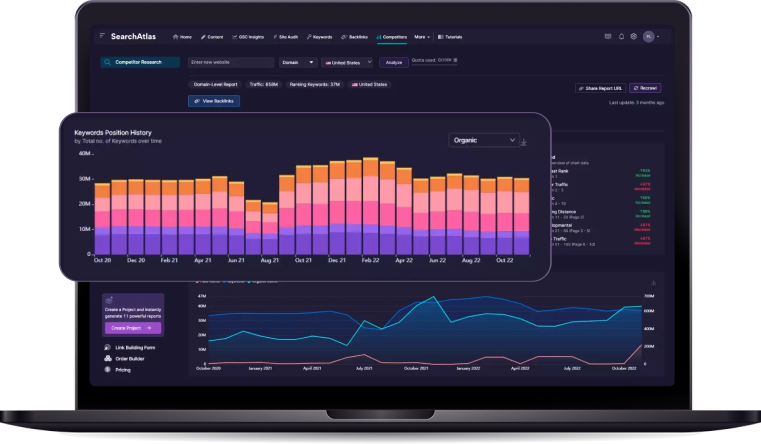
How to Whitelist the Search Atlas Site Auditor – Step by Step Guide
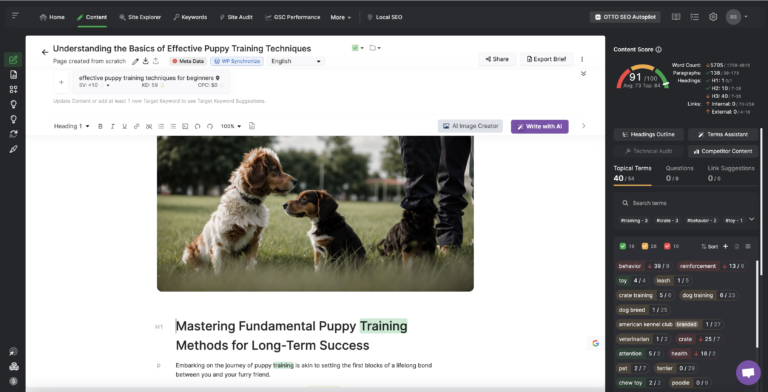
How to Use Search Atlas AI Writer for SEO Writing

How to Find Your Search Atlas Affiliate Code

Unlocking Technical SEO: The Importance of Schema Markup

Maximizing Efficiency: The Benefits of White Label Reporting Tools for Agencies

Keyword Research Tool API

SearchAtlas Keyword Research Search Tool

SearchAtlas Keyword Research Search Volume

IMAGES
VIDEO
COMMENTS
Transitional words and phrases can create powerful links between ideas in your paper and can help your reader understand the logic of your paper. However, these words all have different meanings, nuances, and connotations. Before using a particular transitional word in your paper, be sure you understand its meaning and usage completely and be sure…
Level Up Your Team. See why leading organizations rely on MasterClass for learning & development. Transition words are useful for all types of writers. Whether you're attempting academic writing, blogging, speech writing, or writing fiction, transition words can help refine your text and create a narrative flow.
4 Writing Tips. Transitional words and phrases in fiction, as in nonfiction, aid smooth movement between paragraphs, chapters, scenes, ideas, locations, times and characters. Effective transitions act as bridges that move the reader logically from one point to another, unobtrusively, without awkwardness. They may use special "transition" words ...
A transition between paragraphs can be a word or two (however, for example, similarly), a phrase, or a sentence. Transitions can be at the end of the first paragraph, at the beginning of the second paragraph, or in both places. Transitions within paragraphs: As with transitions between sections and paragraphs, transitions within paragraphs act ...
Example sentence. Transition words and phrases. Addition. We found that the mixture was effective. Moreover, it appeared to have additional effects we had not predicted. indeed, furthermore, moreover, additionally, and, also, both x and y, not only x but also y, besides x, in fact. Introduction.
Transitions. Transitions help your readers move between ideas within a paragraph, between paragraphs, or between sections of your argument. When you are deciding how to transition from one idea to the next, your goal should be to help readers see how your ideas are connected—and how those ideas connect to the big picture.
Common Transition Words and Phrases. ... 9. Emphasis. Use to suggest that an idea is particularly important to your argument important to note, most of all, a significant factor, a primary concern, a key feature, remember that, pay particular attention to, a central issue, the most substantial issue, the main value, a major event, the chief factor, a distinctive quality, especially valuable ...
A speeding car came around the corner. Rewrite: The boy kicked the ball into the street. At the same moment, a speeding car came around the corner. The rewrite uses a transition phrase to show when the event happened. We see the action in a wider lens: the ball goes into the street just as a car comes careening around the corner.
Coherence. In Style: Lessons in Clarity and Grace, Joseph Williams and Joseph Bizup also write about the importance of coherence.While "cohesion" and "coherence" sound similar, they are two different things. "Cohesion" is about ideas that connect to each other "the way two pieces of a jigsaw puzzle do," whereas "coherence" "is when all the sentences in a piece of writing ...
Transition words make writing easy to read. All this talk about organization, logical structure, and good flow and clarity pool together to deliver the champion writing characteristic - good readability. That's when your content is easy to read, gently pushing the reader from one sentence to another until they get through to the end. Bingo!
Altogether. After all. Ultimately. Here's an example of this type of transition in use: "Traveling make you more open to new experiences, which increases your willingness to try new things in the future. It also increases your brain's capacity and attentiveness in future situations that are new and challenging.
Use these 14 Types of Transition Vocabulary In Creative Writing. Effective transitions help connect ideas and make it easier for readers to follow along with the story or information. By using connecting words and phrases, writers often make their work easier to understand and flow better.
Transition words can also be employed in creative writing, speeches, and even everyday conversations to make the discourse more coherent and persuasive. Both non-native speakers and native speakers could benefit from studying less frequent transition words.
Transition words commonly appear at the start of a new sentence or clause ... Prof. Buckhoff, and Prof. Dowell at Michigan State University under a Creative Commons license. ... Misused transition words can make your writing unclear or illogical. Your audience will be easily lost if you misrepresent the connections between your sentences and ideas.
Sequential transition words. Sequential transition words are useful when outlining a step-by-step process or a sequence of events. They help readers understand the time, order, and sequence of your ideas. Some good examples include "then," "first," "in addition," "subsequently," "afterward," "to begin with," "second ...
When it comes to creative writing, we all have our "style". Some people like to use fewer words and shorter sentences, while others of us (I'm guilty of this) prefer to go with longer sentences that use more flowing words. ... or becoming run-on sentences. Transition words are useful to help you put together better longer sentences. Transition ...
Transitions. Transitions are the bridges between parts of your paper. They help to create both coherence and cohesion in a paper (aka "flow"), and they enable the reader to make the logical connections between the writer's ideas in the way that the writer intends. Transitions help carry a thought from sentence to sentence, one idea to ...
33 Transition Words and Phrases. 'Besides,' 'furthermore,' 'although,' and other words to help you jump from one idea to the next. Transitional terms give writers the opportunity to prepare readers for a new idea, connecting the previous sentence to the next one. Many transitional words are nearly synonymous: words that broadly indicate that ...
Transition Words & Phrases are words and phrases (aka signs or signposts) that writers and speakers use to help their readers, listeners, or users understand the flow of information across a text. Transitional Words refers to elements of spoken and written language (e.g., words, phrases, sentences, paragraphs, and sections) that authors use to ...
Transition Words Are Essential Linguistic Devices Serving as Bridges Between Sentences and Enhancing Readability. Strategic Deployment of Transition Words Is Crucial for Maintaining Momentum and Cohesiveness in Writing. Tailoring Transition Word Usage to the Genre and Writing Style Enhances Narrative Flow and Reader Engagement.
As they transition from the storyboard to a written draft, the transition words can be included. Discuss story events with students orally. As you summarize the book, use and emphasize specific transition words, "First the kids went in the snow. Then they built a snowman. Finally they came inside for hot chocolate." Challenge students by ...